Category: Longform
You are viewing all posts from this category, beginning with the most recent.
Halfway there? Or am I finished? A battle of will!
Today started out promising. Like any morning in the camper I made myself some coffee. Unlike most mornings the cell service at Pere Marquette was so bad that the best my devices could muster was a few received emails overnight. Despite Two bars of service digital was just out of the question. Obviously this cell is not designed to handle the volume of traffic at the park. Anything real time was out of the question.
I did pull up the weather and managed to get a frame of radar. Not good! We turned on the TV since we got good TV reception and the weatherman summed it up. Rain this morning, then 30 mph winds for the afternoon with severe weather to follow after noon and late this afternoon. Ugh! So we walked up to the lodge where they had super-fast wifi and confirmed all of this. Yep, lots of rain on the way, then what looked like a break, maybe followed by more rain.
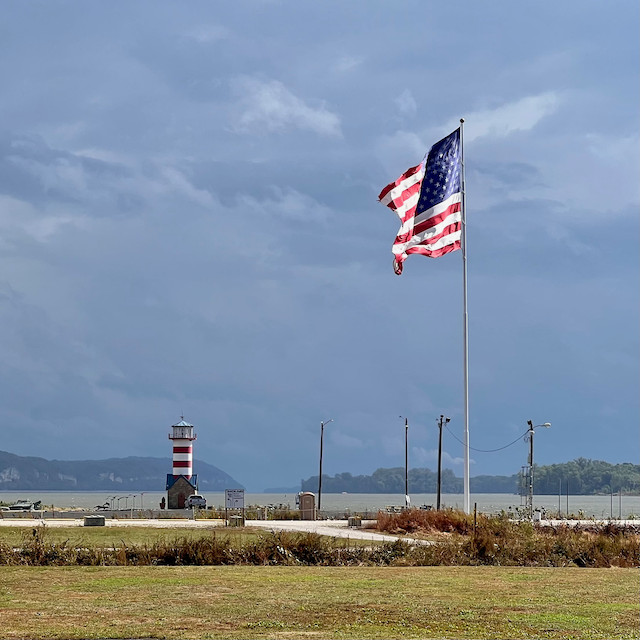
OK, so I’ll work this morning and leave after the rain hopefully finishing before the afternoon showers hit! Great idea. Around 11:00 we saw the sun, so I helped Jane get the camper hooked up, then got my stuff ready and headed out on my bike. The trail, which I had been looking forward to, was a mess! Mud puddles, Mud, downed tree branches, etc. My legs were caked with mud before I had gone 6 miles. The wind out of the SSE was quickly becoming a pain.
When I saw Jane go by on the highway I thought “maybe she’ll stop and I’ll be done for the day.” No such luck, OK, I am going to do this I told myself. It seems that cross country biking is a battle of will! Then I got on the highway where the bike lane was nicer, but the wind was fierce. I continued on for another 15 miles, not making great progress, until I noticed I was no longer on the route. Somewhere the bike path had gone to the right but I had continued following the highway. But just ahead was a turnout where I could get back on the path. I’m not sure I should have as the path was on top of the levee, well above the highway! At times I was riding at a 20 degree angle into the side wind! But I don’t think my day was as challenging as this barge driver! He was trying to get the barges into the lock but clearly heading for the shore due to the high winds!
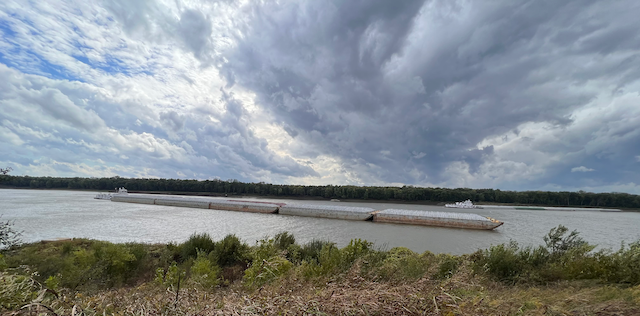
I seemed to continue along the top of the levee in the wind forever. At the Lewis and Clark memorial I contemplated calling Jane again, but I kept on going. About two miles after the memorial I really regretted my decision as the bike path inexplicably turned to gravel, nice rain softened gravel! That continued for at least two or three miles until I got to the bridge to cross the Mississippi back into Missouri. Getting off the levee and back onto the road was hard as the path was chained shut. I felt very isolated and alone, and it looked like nobody had biked this path for years. Tires, old furniture, all kinds of crap had been thrown off the bridge I was to cross… Yuk!
A few miles later I crossed the beautiful “Chain of Rocks” bridge. Definitely a sight to behold, but by the time I got to the end of the bridge it was pouring. Thankfully there was a covered rest area at the end of the bridge. This time I did call Jane. But she was on her bike headed out to meet me! She is amazing, she was headed out to meet me so I could draft off her on her ebike for the final 10 miles. “I’m almost to the chain of rocks bridge” she said. “OK, its letting up, I’ll meet you” I replied. But I kept riding and riding and no sign of her! So I brought here up on “Find my Friends” Ok I’m getting close but she doesn’t seem to be moving! At that point I got a little nervous, but as I got to the point where here icon was on find my and my blue dot showed me, I could see she was standing. Waiting for me? Nope she had ridden through a pile of glass and had a flat tire! Also no spare tube or tire changing tools. How could I let her ride without a spare!!??
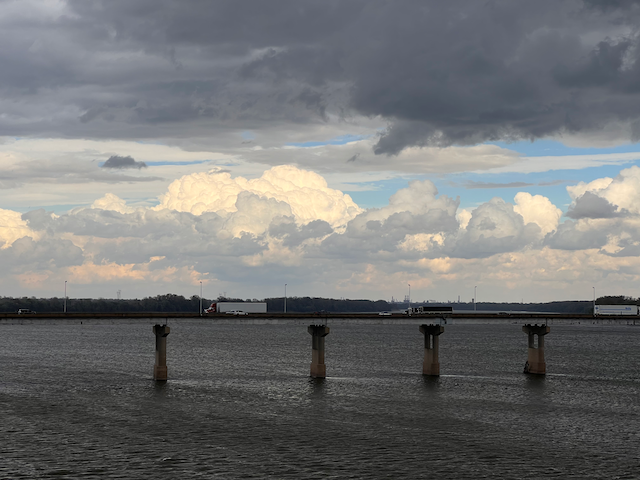
Maybe an Uber was the solution, but I didn’t like the idea of her waiting around for me to get back to her, or her riding in an Uber and me just hanging out for an hour for her to come back. So I tried the first step. Just pump up the tire again. No go! Ok, my tubes are not made for her tires, but they will definitely work in a pinch. So I took off her tire and replaced the tube with my spare. We vowed to carry our bikes over the area with the glass. That was enough to get us back to the RV park at the King Power / Queens casino RV park in St. Louis.
Back in the camper, my back is sore from fighting the wind all day and my attitude is marginal at best. I can’t decide if I want to say I made it halfway down the Mississippi or if I want to continue.
Parts of this ride are great and beautiful, and parts of the trip are just gross.
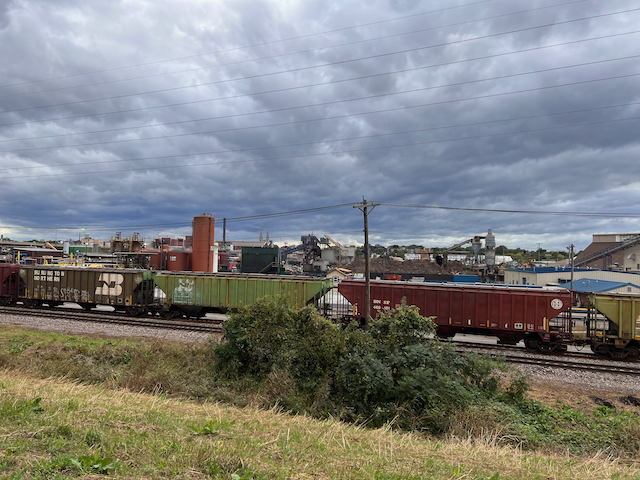
We will see what tomorrow brings but my bet is on me continuing despite past challenges, and future worries. This feels to me like one of those junior high english class “man against nature” challenges, and in the moment that is exactly what it is! What me give up?! Never! On the other hand I only did this because I thought it would be fun. Today was not fun, today was a whole lotta work. I beat the wind and rain and the elements, but at the end of the day I’m tired and my back hurts, and the Alleve isn’t working, and I’m no fun for Jane to hang out with. So we will see what tomorrow brings!
Stay tuned!
Not that kind of biker
Although today was a “day of rest” we still made a short ride into Grafton for lunch. I’ll ride this same path again tomorrow so this made up for a little of yesterday’s ride in the truck.
As we rode into town I saw this big sign, “Bikers Welcome”
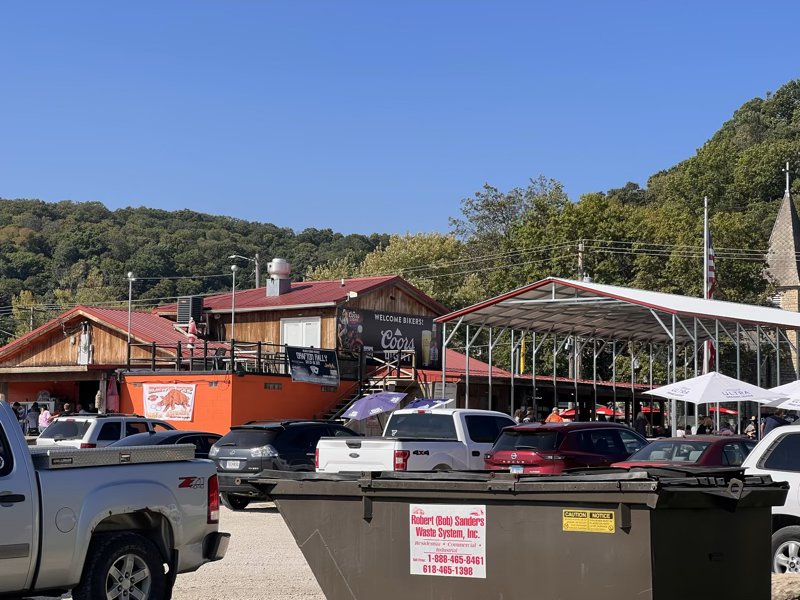
Nice! I thought until we noticed the 100 or so Harleys parked outside. The banner in the back is also advertising “The Hawg Pit”. Needless to say we did not stop there for our lunch. We continued on to the Grafton Brewhouse and Winery where we had some pretty good burgers and decent beer. I think they source some of their grapes from California as I did have a nice chardonnay. Good enough that I bought a bottle.
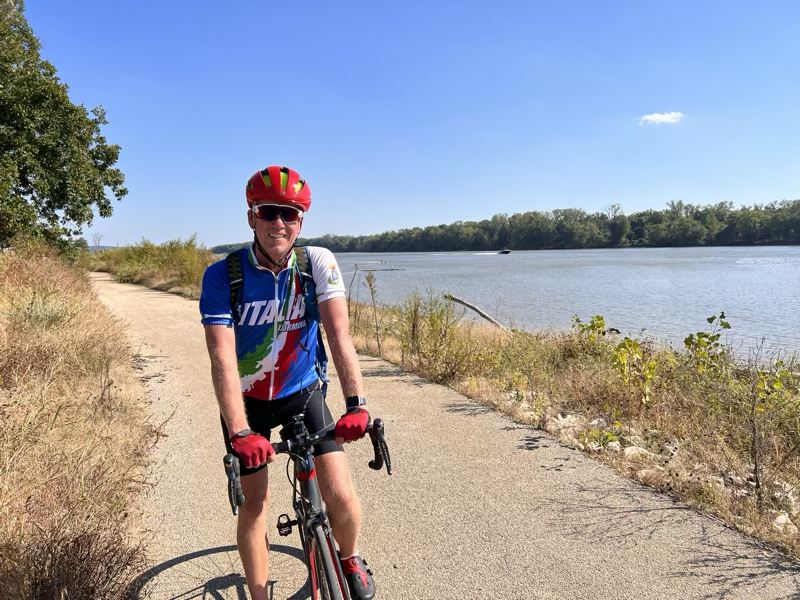
In case you are looking for a fancy place to stay…
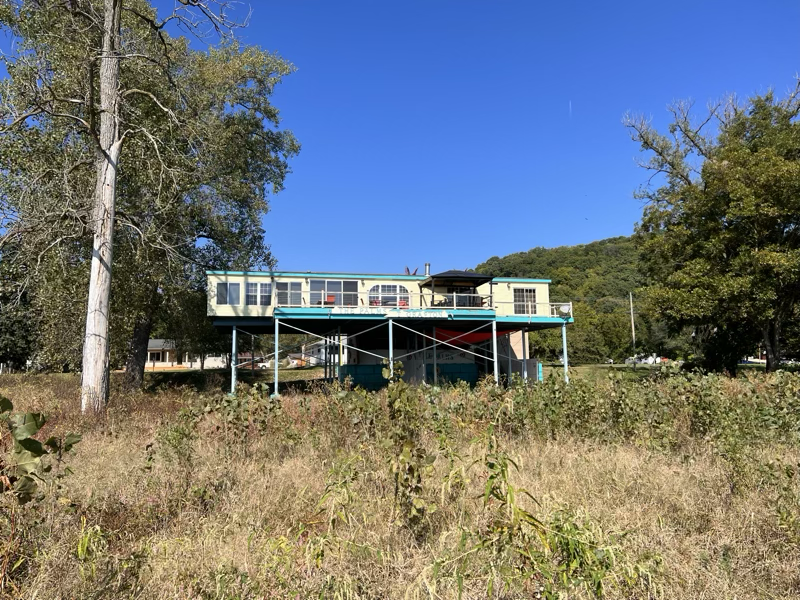
Hannibal / Hamberg to Pere Marquette
I awoke with heavy legs this morning! The plan was for Jane to drive me back across the river, retracing part of my ride from yesterday. Then, to drop me off so I could ride to the State Park. Sometimes things don’t go quite as planned.
A mile or two into the ride, maybe even less I noticed that I had a flat. Not so bad, I haven’t had any flat tires for quite a while now. So I pulled over to make the change only to discover that I had left my pump in the camper! Thankfully Jane was only a few miles down the road, and I had cell service. She came back with the pump and another tire and a bit later I was changed and on my way.
Less than a mile down the road I was flat again. Grrr… Maybe it was the tired legs, or the heat, or whatever but that was the last straw for me. On the phone again to Jane. “I guess I was not meant to ride today.” So back she came again. As I was waiting I took the whole tire off and once again felt inch by inch to see if I could find something. Finally I found a tiny sharp spine that had somehow worked its way through. I had missed it the first time around but not now. Still, when Jane got back I put the bike on the rack and hopped in the truck.
I sat there stewing and angry about flat tires for quite a few miles before I finally decided that maybe it was time to pull off, fix the tire and ride the rest of the way.
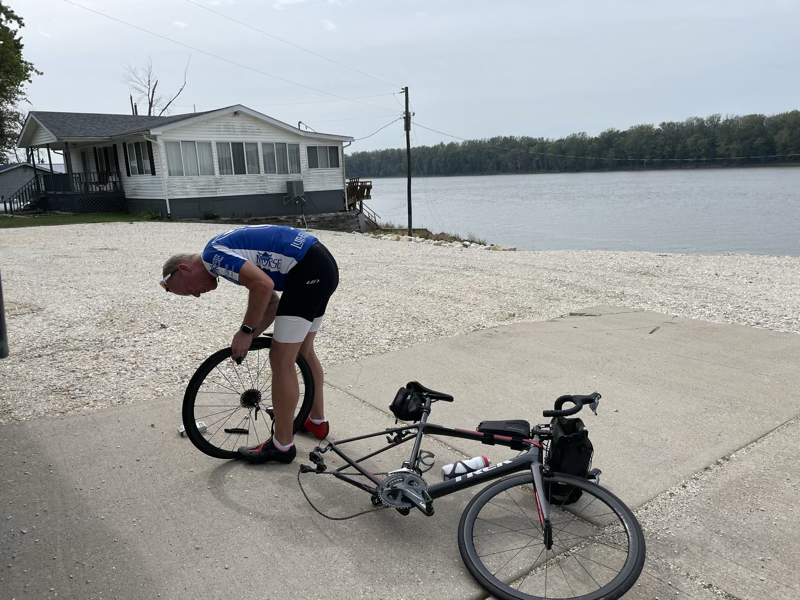
The first part of the abbreviated ride was from Hamberg, which was on some beautiful country roads. Here I am as Jane decided to follow me for a few miles just to be sure.
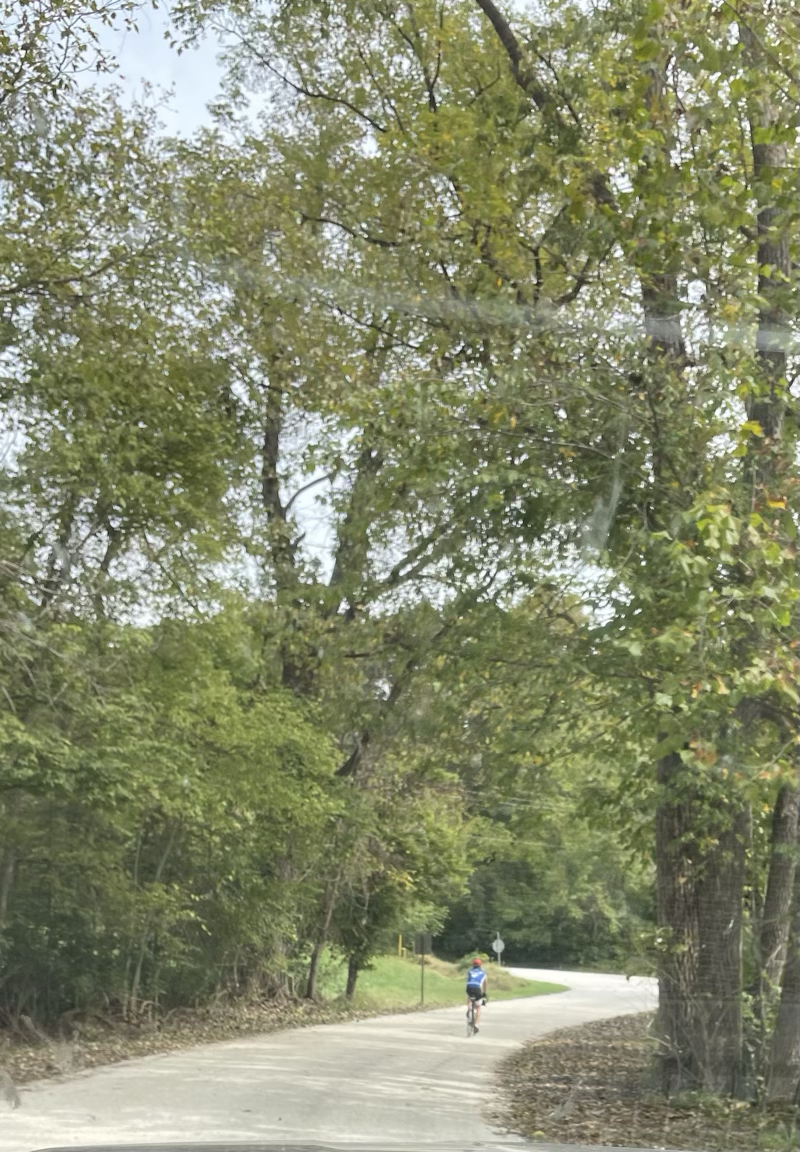
The second part of the ride was along a pretty busy Illinois Hwy 100. Not so great, but here I am crossing the Illinois river about 15 miles short of Pere Marquette State Park.
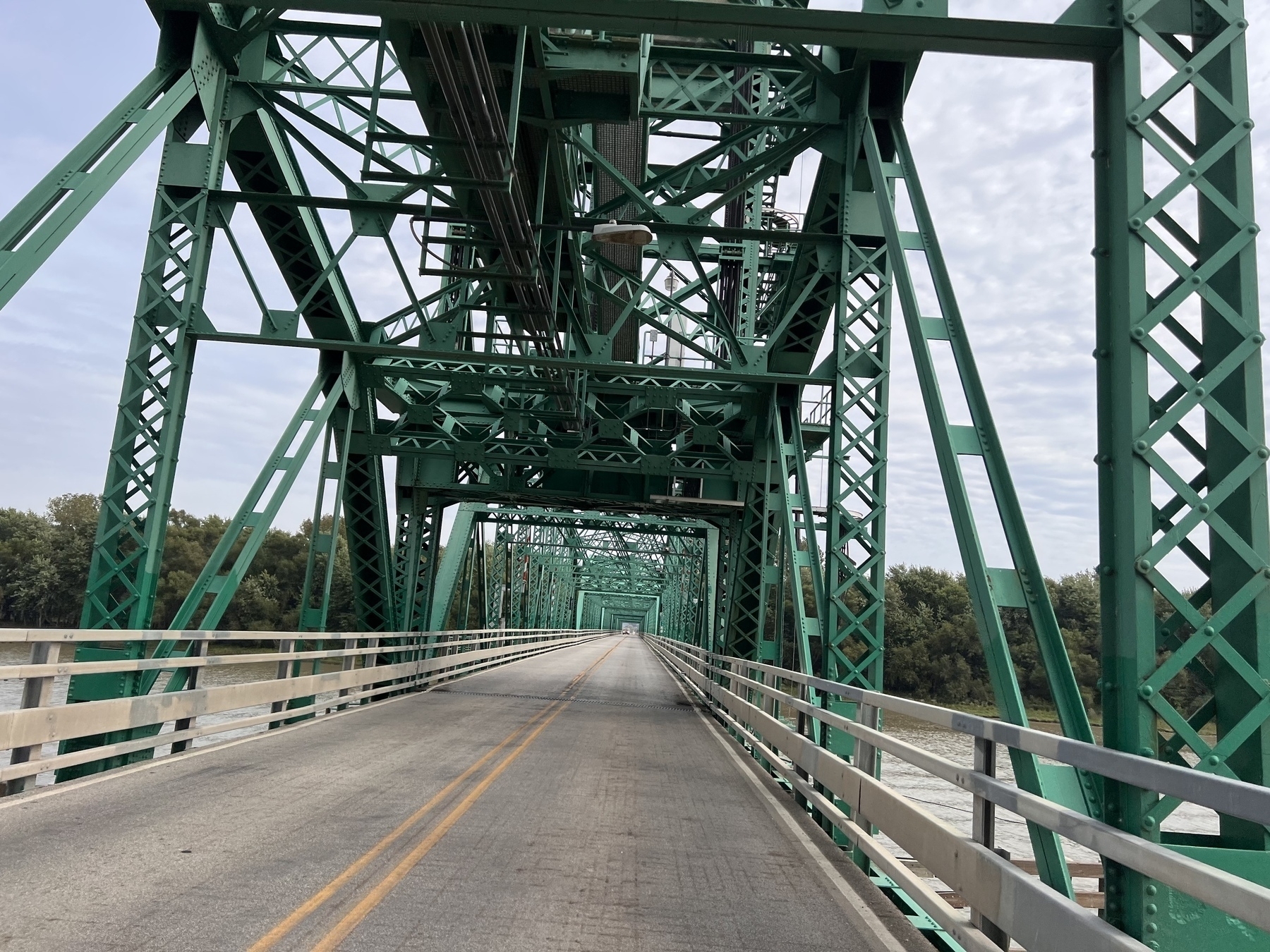
We put the Instant Pot to work to make some ribs which we finished over our campfire and some cheesy rice. Tomorrow is scheduled to be a day of rest.
Nauvoo to Hannibal
Today was a total washout. I woke up and looked at the forecast and radar only to see a huge patch of rain heading our way. Strangely from east to west. I guess we are in the south now? I just had time to get the bike on the rack and get them covered up before the rain started. So we had a nice breakfast and watched the radar. Clearly an all day thing. I am not into riding all day in the rain so today became a day off. When the rain finally did let up, we did a short hike at Wildcat Den State Park and then drove to Nauvoo.
Here is what it looks like when you are the only camper in the campground!
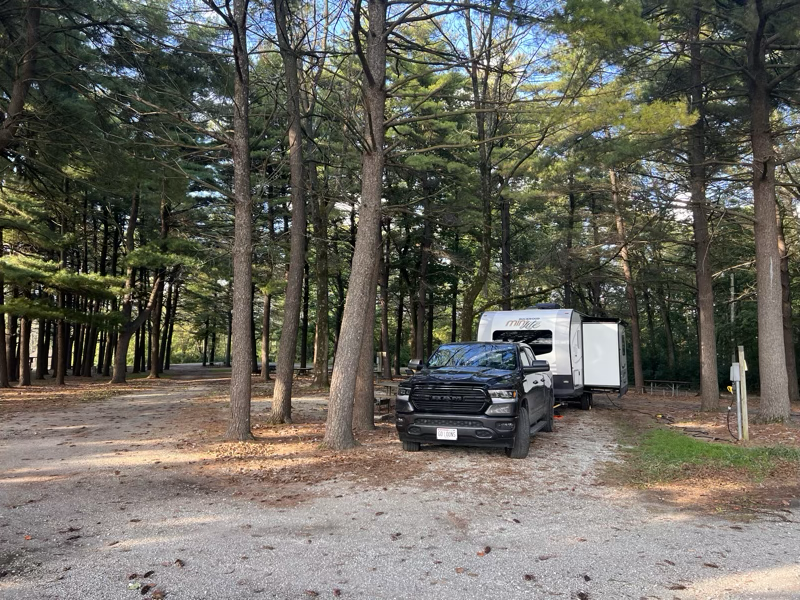
Nauvoo, home to the grave of Joseph Smith and one really big Mormon temple looked like a pretty sleepy little town as we pulled in. The town turned out to be larger than we thought, but it was still pretty quiet. After setting up camp we took a short walk to the oldest winery in Illinois. We keep trying to convince ourselves that we will find a good wine somewhere along the Mississippi. 🤣
The morning came and the sun was out, a great day to ride to ride. the first part of the day was beautiful, following the river right at river level.
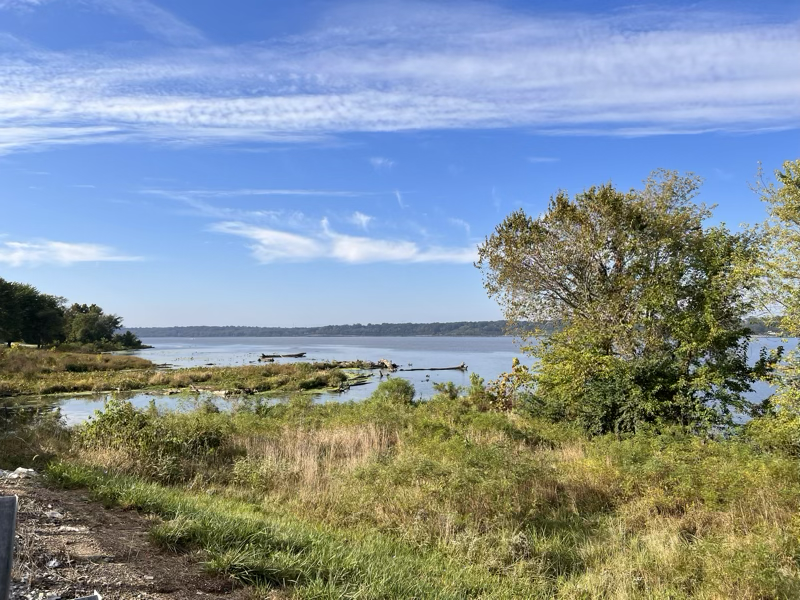
As the day wore on I got further away from the river and more into farmland as well as higher temperatures and a bit of a southern breeze. A different kind of scenery but it was fun to see the harvest in progress.
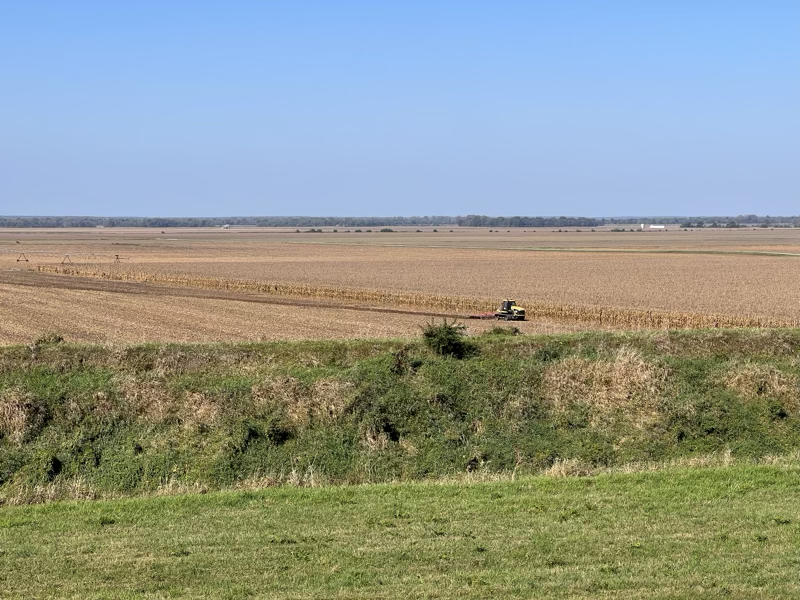
Heading into Hannibal I rode across the Mississippi on I72 - the only stretch of Interstate in Illinois where bikes are allowed. At this point I was getting pretty tired of riding into the wind and I was low on water, so thankfully I was getting close. After the bridge it was all downhill into Hannibal. Unfortunately our campground was not in downtown, it was outside of Hannibal on the other side of a hill!
One shower and a gallon of water later I was ready to head back into town. We decided, unsurprisingly, on a pizza/pasta place called the brick oven. We were lucky I was ready for an early supper as by the time we left there was a very long waiting list.
Of course when in town you have to stop and help Tom Sawyer whitewash a fence.
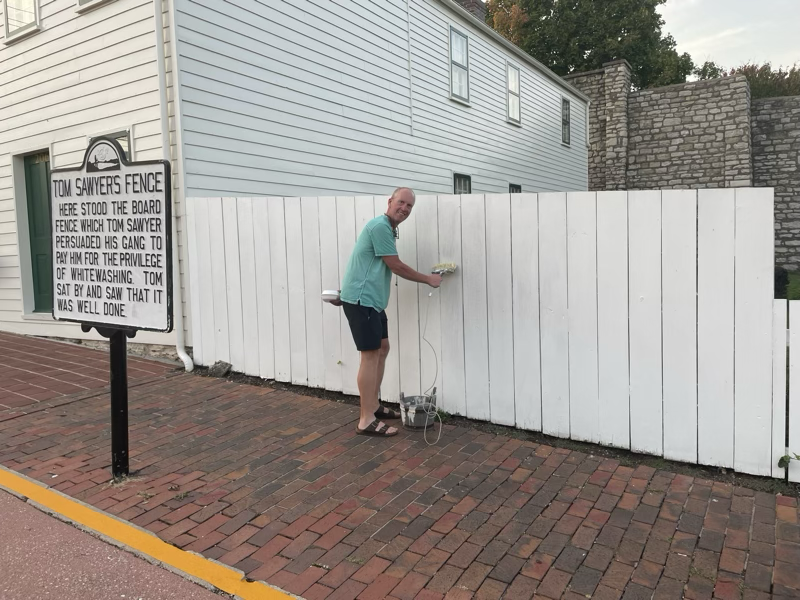
On the way back to camp we stopped at Lovers Leap where we had a beautiful view of the river and Hannibal.
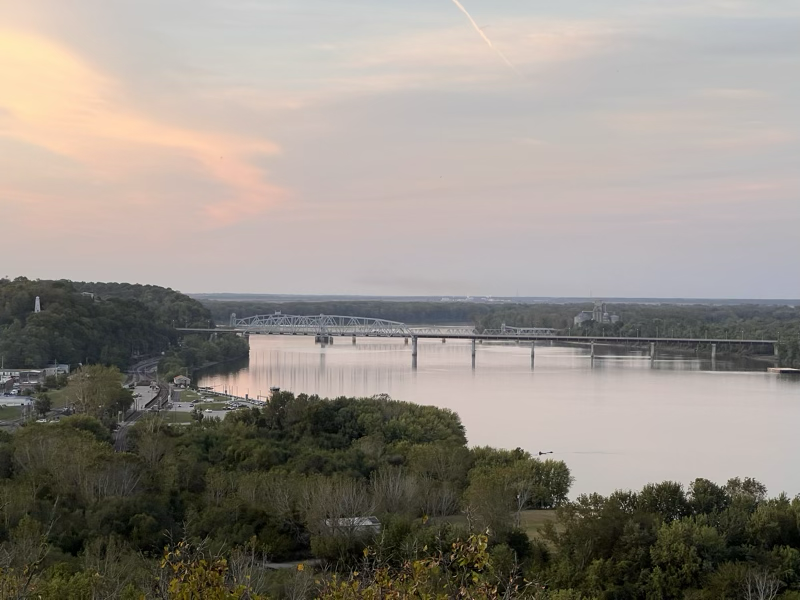
I did manage to stay awake until 10, even knowing that I had another 80 miles on the schedule for the next day.
Mississippi Palisades to Muscatine
Today I did 86 miles but it was a very relaxing day of riding. The majority of the day was on trails and it was nice to be away from traffic and goats. At one point I was riding right along the top of the levee but most of the time was just through nice rural roads and trails.
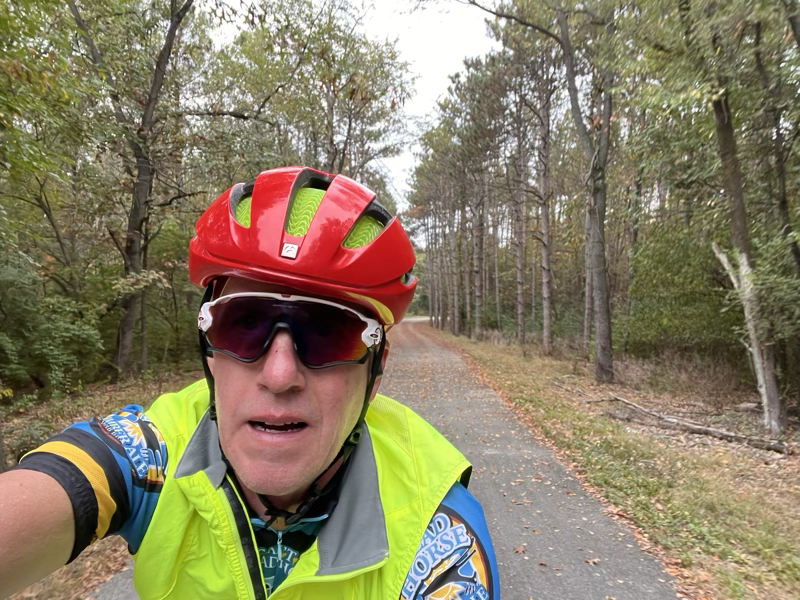
I had to make a stop at the local Caseys to buy a couple of bottles of water since I somehow managed to leave the camper with everything but my water bottles. I now have a morning checklist to make sure I don’t forget stuff!
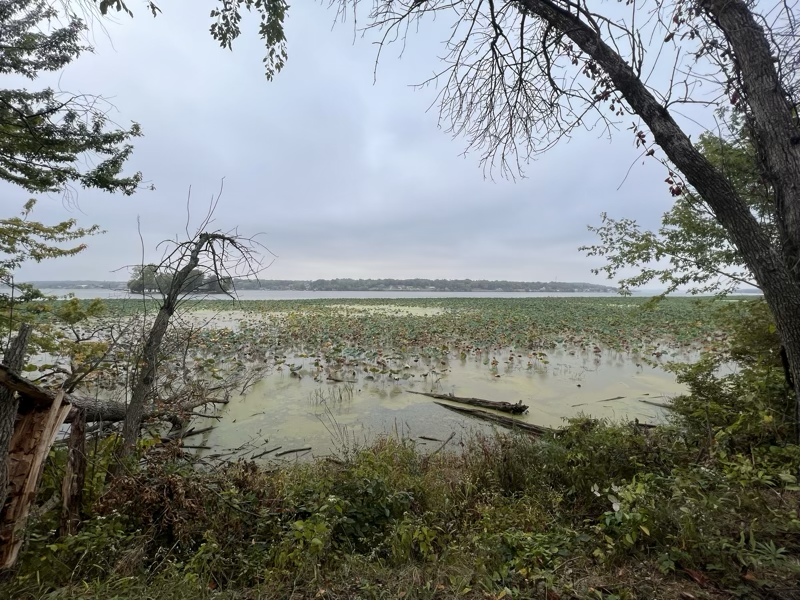
My route today took me through Cordova, where I stopped for lunch and enjoyed the view of the river as well as through East Moline, and Davenport. My one little snag was the bike trail through the parks area of Davenport was closed due to some emergency training drills, so I had to detour on a little busier road.
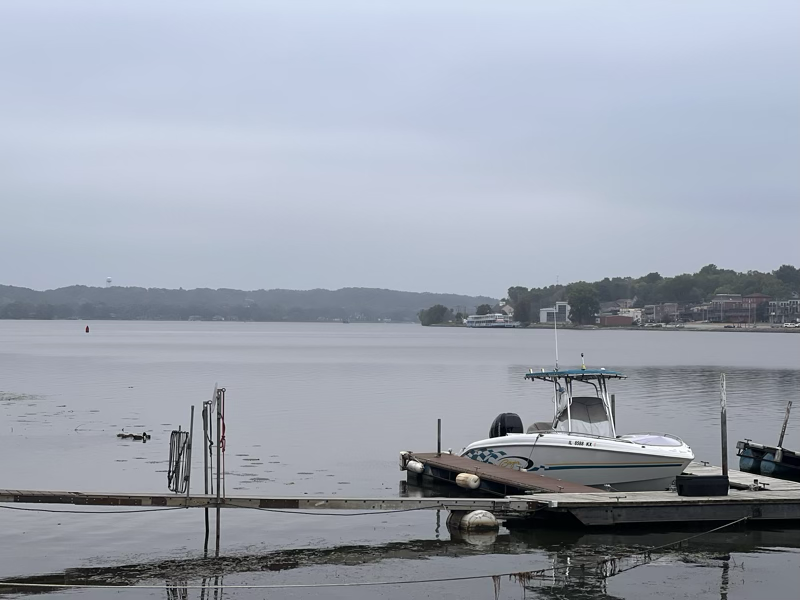
When I arrived at our destination for the night near Muscatine, Jane was sitting in the parking area. It turns out that checkout time is not until 4:00 and the people occupying our site for the night were going to get every last minute out of their stay. After 4:00 there was still no sign they were leaving, and I was sweaty and grumpy and out of patience so I went over to the sight to politely ask when they planned on moving along. It wasn’t the most pleasant conversation I’ve had, but it did get the job done!
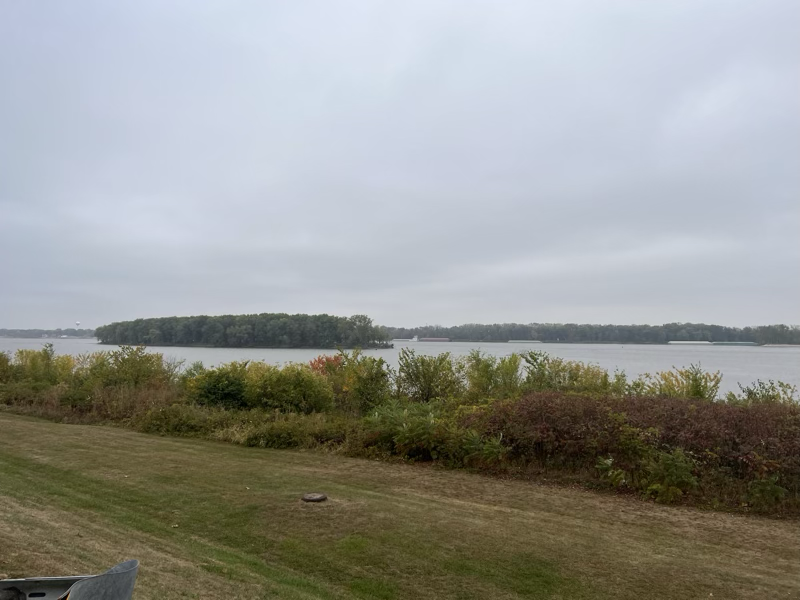
For dinner we had spaghetti and salad. I had not even finished my spaghetti when I had to do a Zoom meeting with a group of students who are working on a project for Runestone for their Senior Capstone. I don’t mind working from the road especially when we have a decent signal. My schedule is a bit unpredictable depending on how far I’m riding and what the weather is, but I seem to be able to keep up with email and do a little development work in my downtime.
Pike’s Peak to Dubuque
After a wonderful weekend in Decorah for our 35 year class reunion, we arrived at Pike’s Peak state park just after dark. This was to be our first time of setting up cam in the dark, but we were not too worried, until we saw a pickup in our spot. Nobody was around and it was just sitting there taking up space. I hopped out of the truck and knocked on the door of the fifth-wheel next door. No answer. Same with the popup on the other side. Grrrr! Suddenly a nice man came quickly down the road. “Sorry, Sorry, I thought this was vacant for tonight and I wanted to recharge a few things. Our spot is not electric!” OK, no problem he moved his truck and we were all good. Time to get a good nights sleep to prepare for the ride.
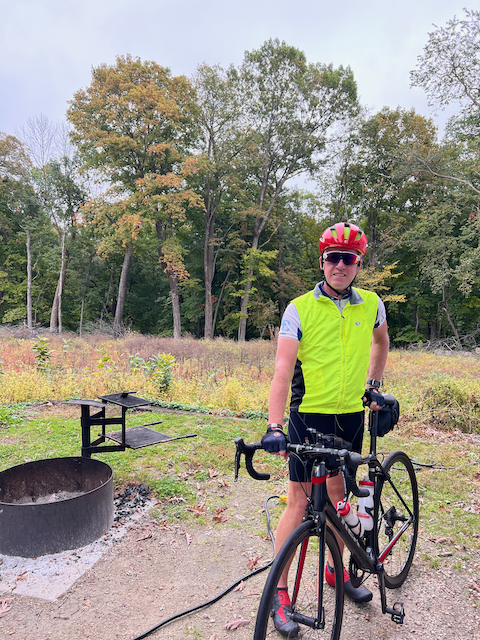
Yesterday was the start of the final push of this journey. Iowa to the Gulf of Mexico! And what a ride it was, 58 miles with lots and lots of climbing. At times I was cruising along high above the river with great views and other times it was just me and my friends.
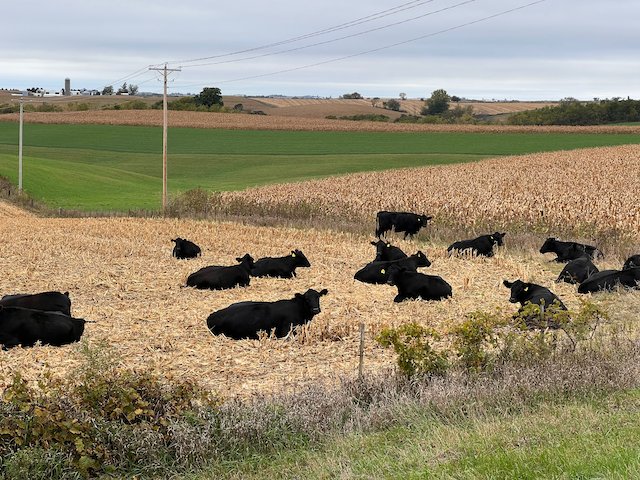
Mostly the roads were good and the motorists were all very courteous. I had a good shoulder to ride on most of the time. I could definitely tell that I had not been doing enough climbing as my back was a little sore and my neck muscles were too by the time I finished the ride for the day.
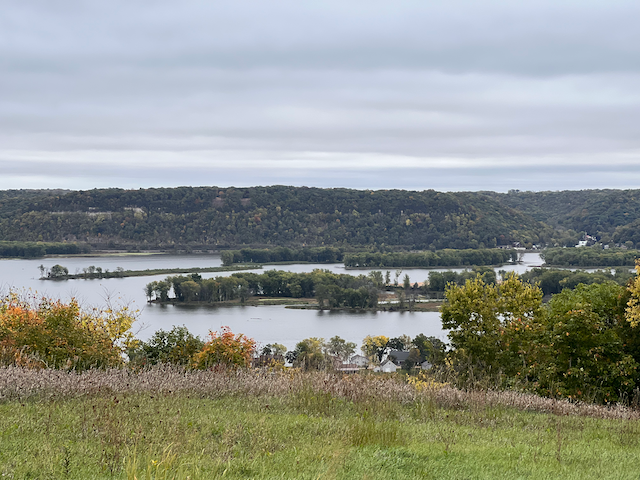
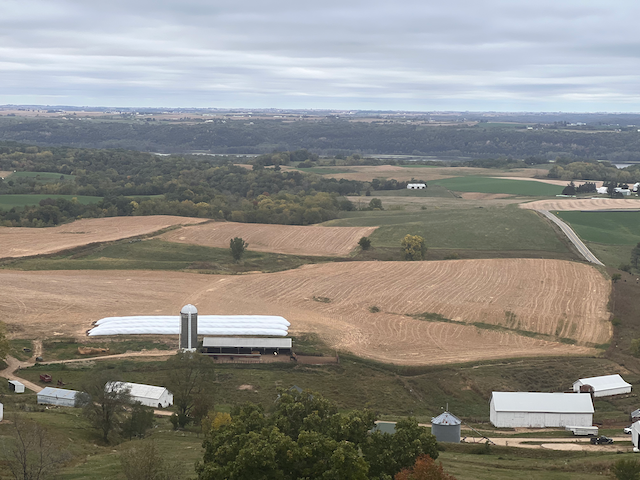
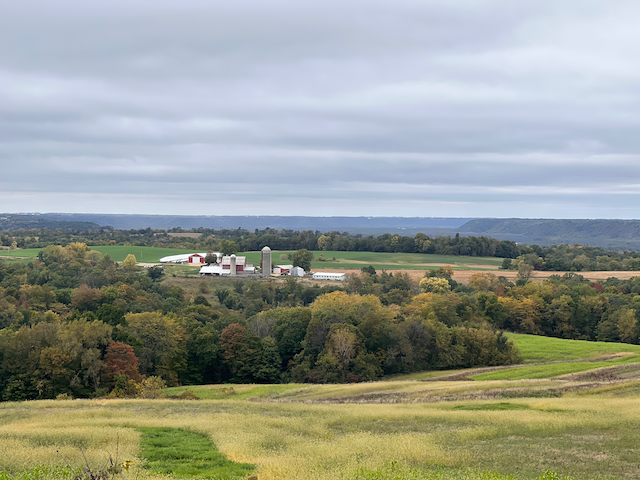
After arriving at the campground in Dubuque Jane was just setting up camp, so I helped finish that task and then did some stretching. We had plans to have dinner with Rachel’s parents (Greg and Peggy Miller) and it turned out to be a wonderful evening. I had some great pasta (Carbs!!) at L May in downtown Dubuque.
This is going to be a great trip. We will see if we settle into a rhythm, but its kind of nice to wake up, have a few hours to work, answer emails, etc. before jumping on the bike again.
02 Bemidji to Brainerd — My First Century
02 Bemidji to Brainerd - My First Century
Yesterday the ride from Itasca to Bemidji turned out to be shorter than expected by 10 miles. Today’s ride turned out to be longer than expected by a good 10 miles. Yesterday started out with a flat tire after only 10 miles. But after the flat the ride was easy and interesting. I crossed the Mississippi “river” several times.
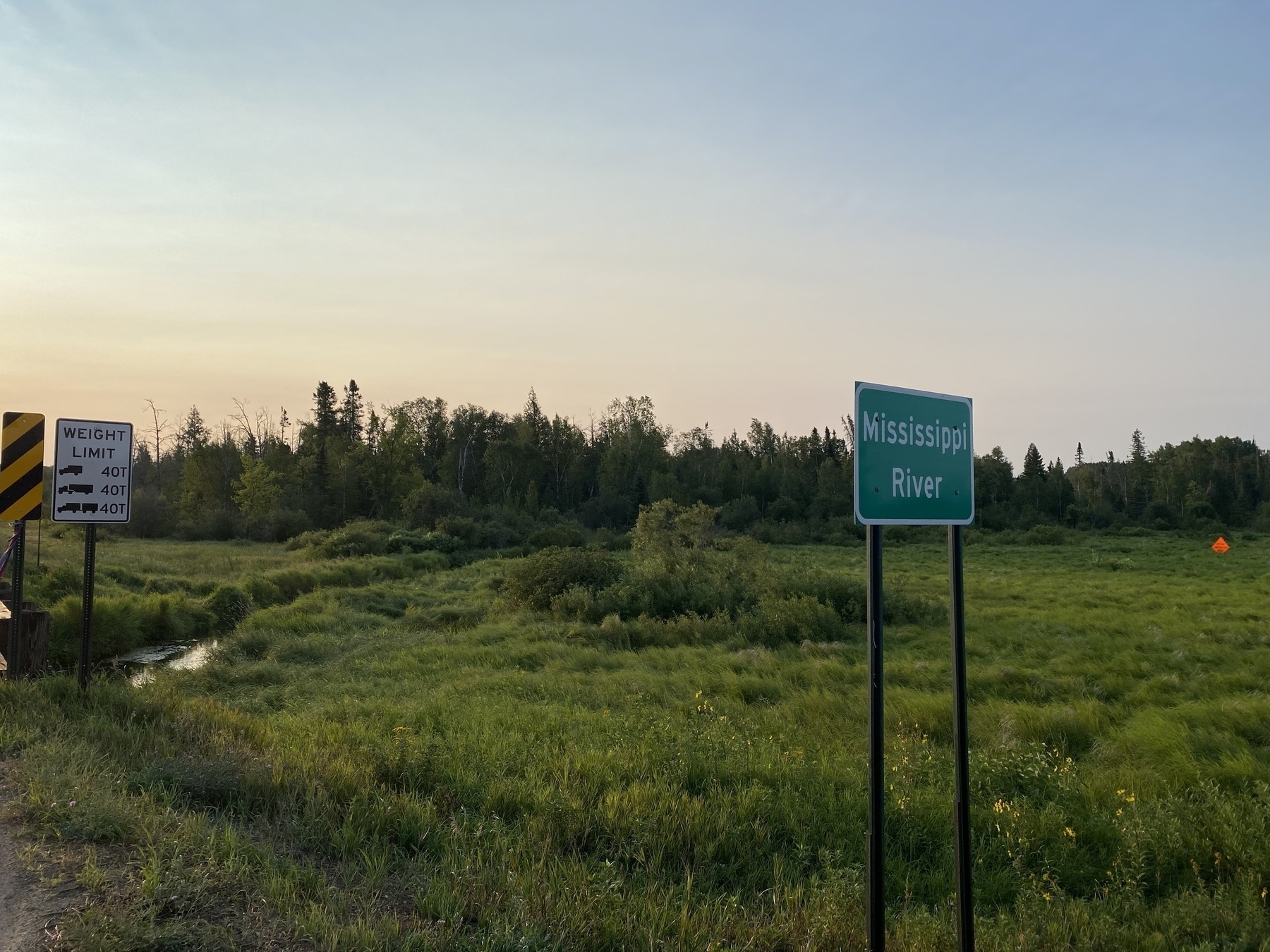
Today began bright and early with a 6:40AM departure from our campsite at Lake Bemidji State Park. The temps were cool, and a stiff breeze out of the south kept me feeling good. Later I would come to appreciate that breeze less and less and the temperatures rose and my legs got more tired. Early in the ride you cross the Mississippi as it exits from Lake Bemidji.
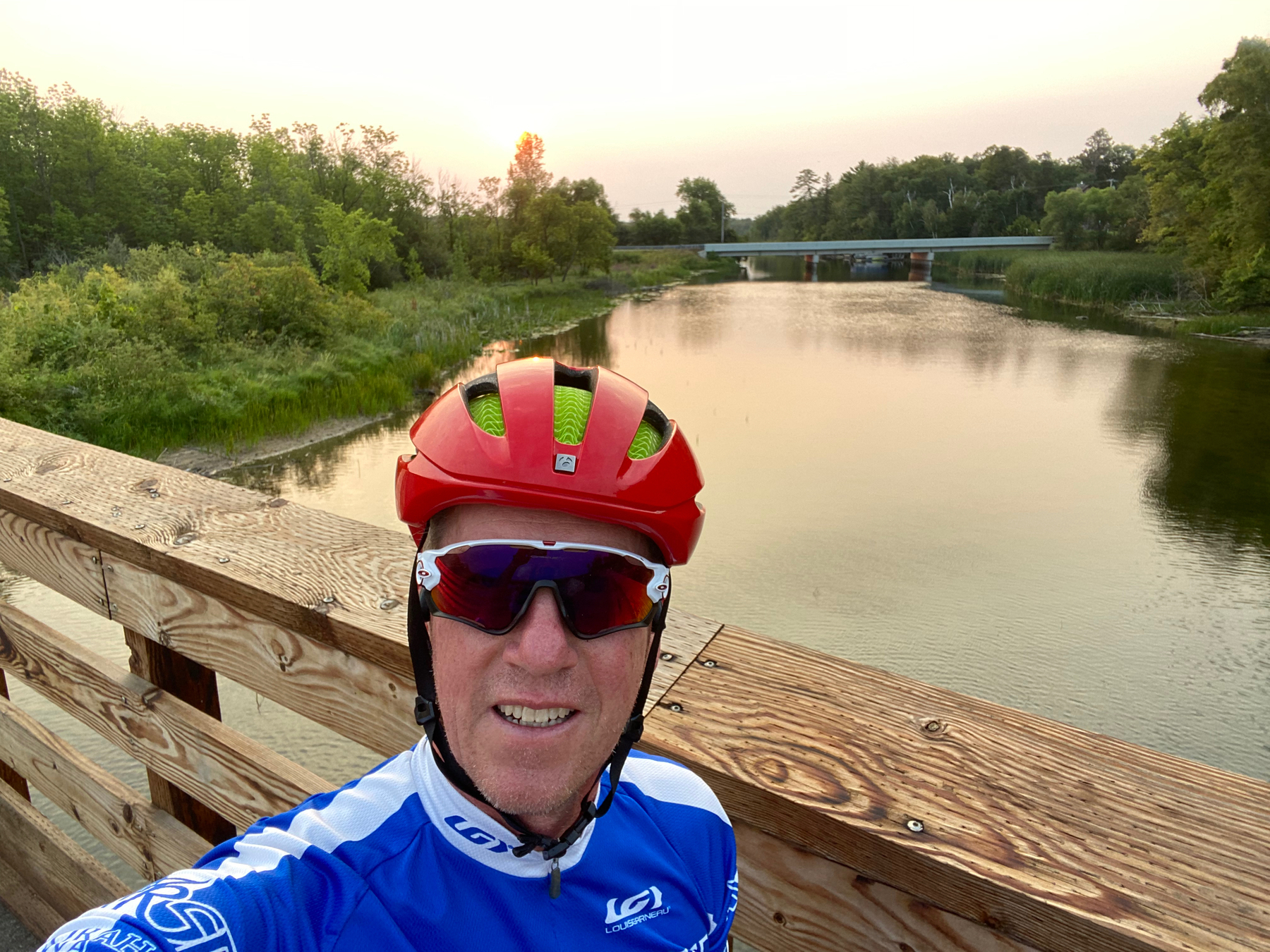
After that, the Paul Bunyan trail does not cross the mississippi like the Mississippi River Trail, but is an official alternate for the MRT, almost all of is on abandoned rail beds and is pretty flat. Everything was very pretty with the morning light.
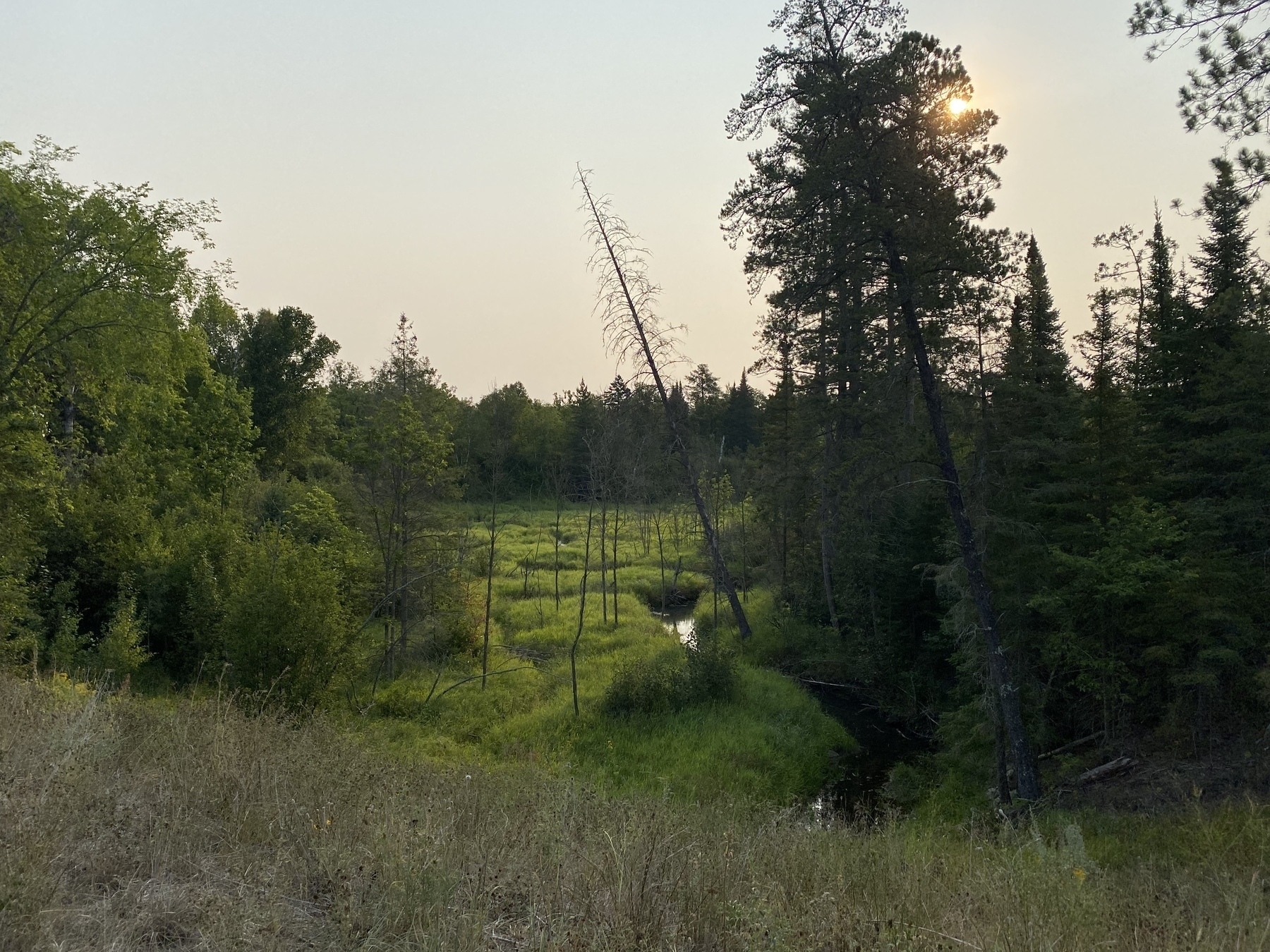
except for one section around Walker (about 50 miles in) that was not very flat, and came at exactly the wrong time in my ride.
At the 79 mile mark Jane was waiting for me with Lunch! It was about 20 miles further than I was ready for it, but that is part of what this first leg of the journey is about. Figuring things out, learning what gear we need and what my limits are.
After lunch my legs were still feeling tired, and the wind kept getting stronger and stronger out of the south. Also less of the trail was tree lined so that made the breeze and the sun both stronger.
I made it to the 100 mile mark!
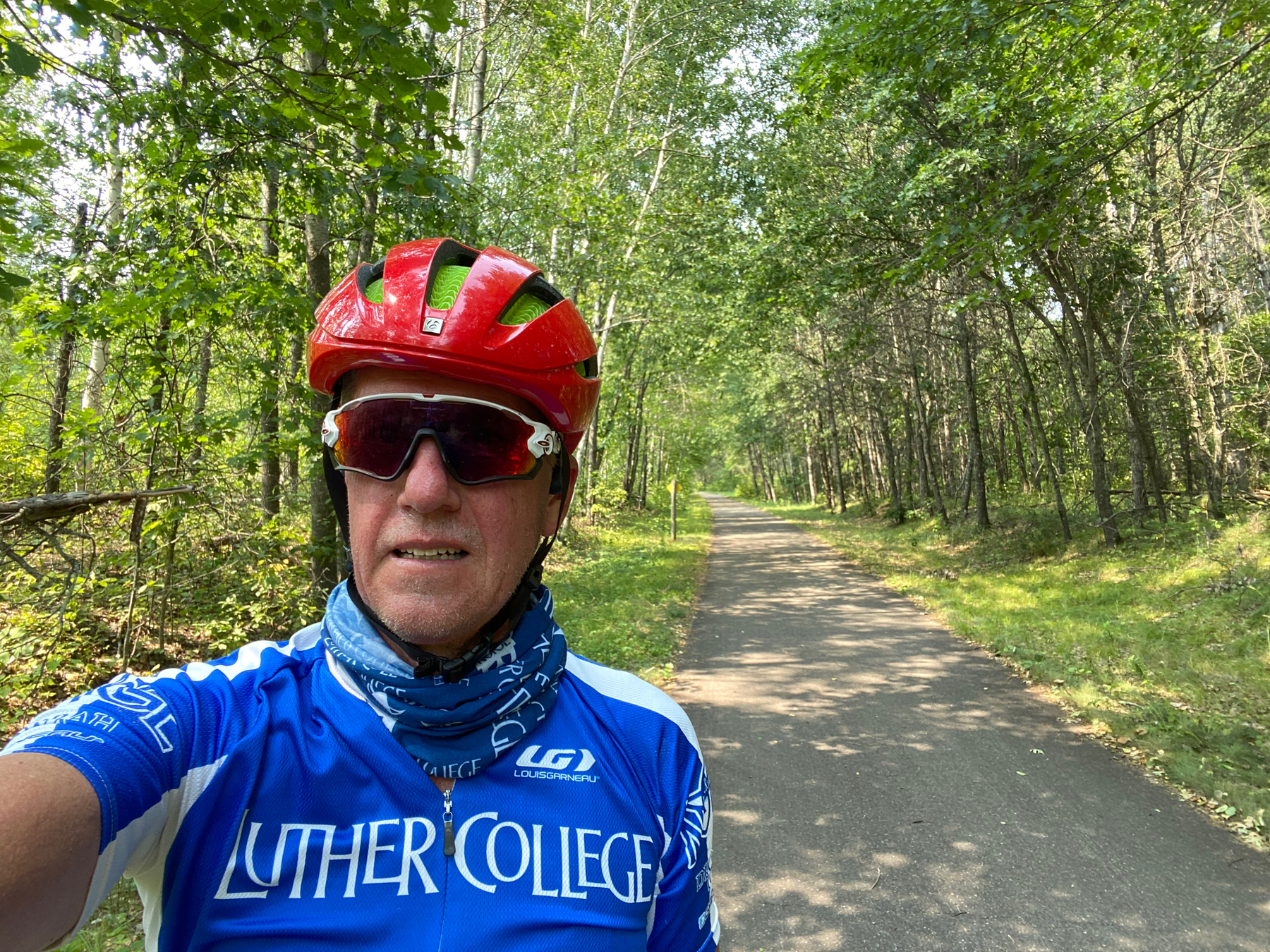
Unfortunately after making 100 it was clear that I still had at least 20 miles left to go. At that point I knew I could make it to Brainerd, but I was probably not going to make it to our campsite south of Brainerd for the night. That is why we have the truck!
Now I’m sitting in the camper writing this post and encouraging my legs to recover their strength for tomorrow. Tomorrow and Thursday are much shorter 68 miles tomorrow and 58 miles on Thursday. Should be a piece of cake!
Prelude (Day 0) Mississippi Headwaters
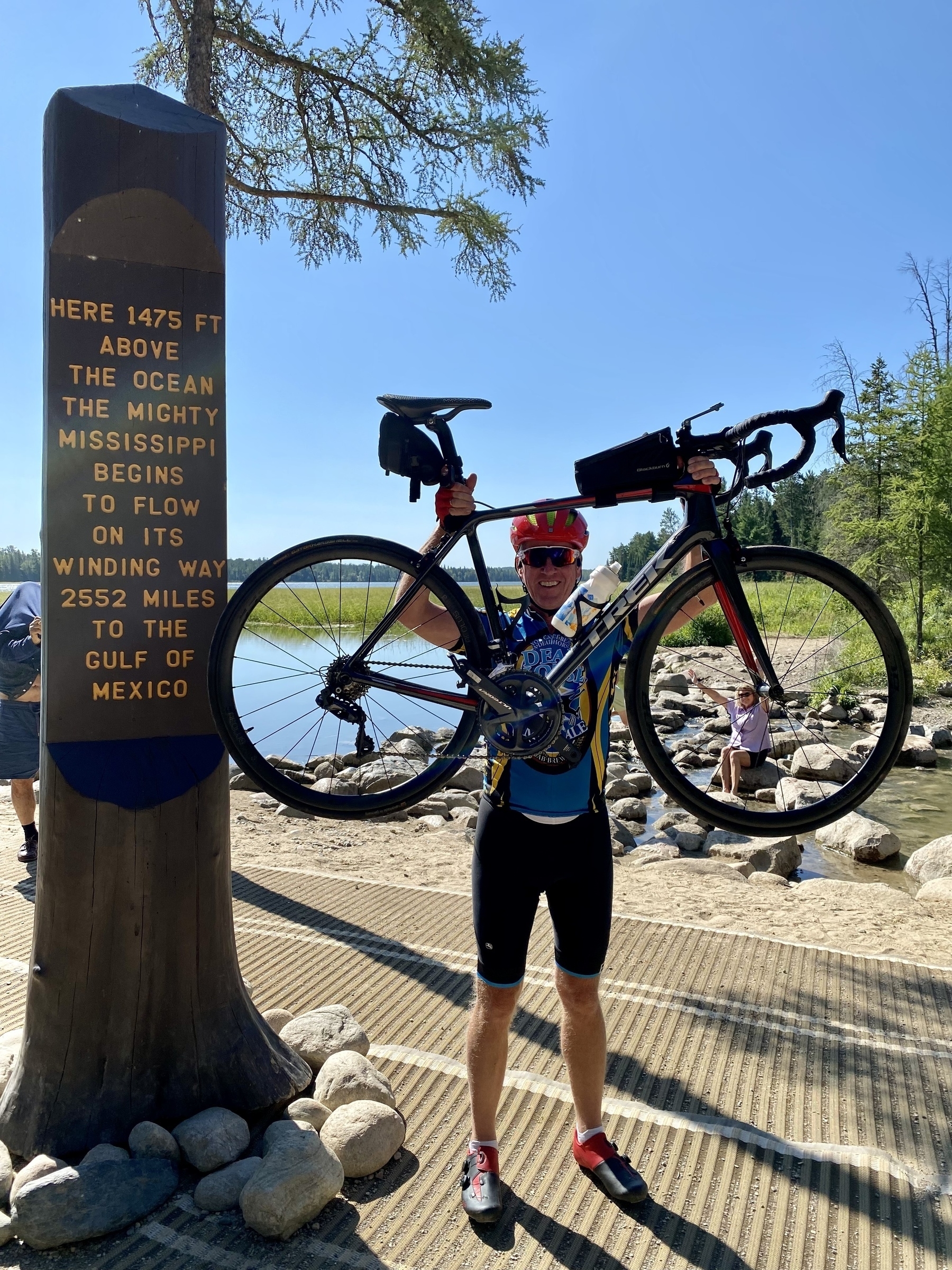
We had a lovely 20 mile ride around Lake Itasca planned for today with a stop at the headwaters of the Mississippi. As the sign says, 2552 miles! That is roughly the length of our journey, in three parts — Its a long way, but at least it is downhill! For those who don’t know what I’m going on about, here is the story.
Sometime earlier this year I said it would be fun to ride the Mississippi from start to finish. It turns out there is a popular route known as the Mississippi River Trail. Its not a bike path but an established route of trails and roads leading from Itasca State Park in Minnesota all the way to the Gulf of Mexico. I’ll be riding my bike and Jane will be riding a bit, pulling the camper, hiking and providing support.
Part I is the ride from Itasca to Minneapolis. This will take place Monday through Thursday this week. It features my first 100+ mile day from Bemidji to Brainerd on the Paul Bunyan trail.
Part II is the ride from Minneapolis to Lansing Iowa. This will be three days starting Labor Day. We’ll end up camping in Decorah prior to Josh and Rachel’s much delayed wedding celebration with friends and family. All fully vaccinated, we hope.
Part III will be from Lansing to the Gulf starting October 4th. We will be back at Luther for our 35 year class Reunion and when that is over we will take off down the river. Most days will be 60 - 70 miles but as we get further south and the route gets flatter I’ll have a few 100+ days.
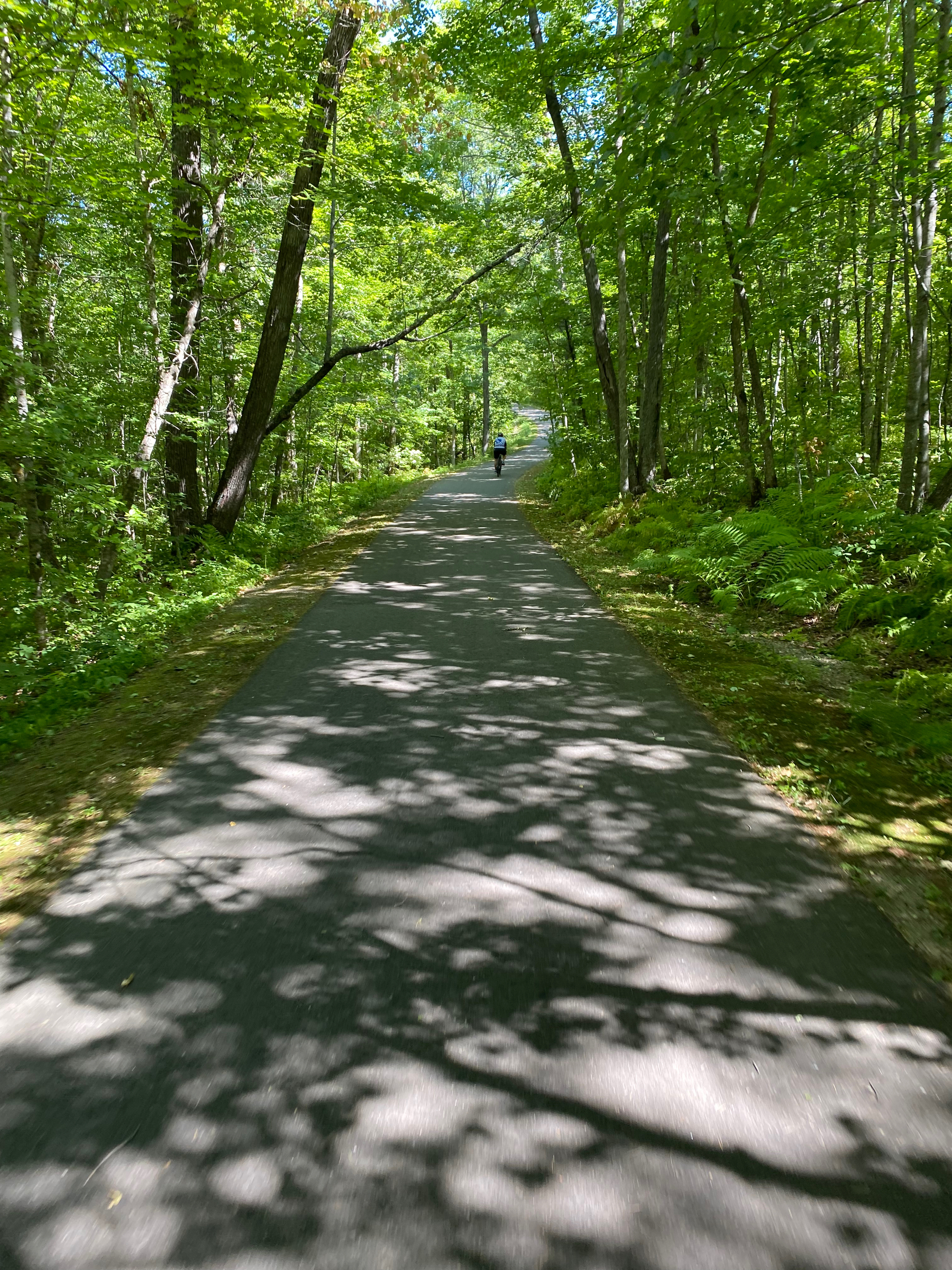
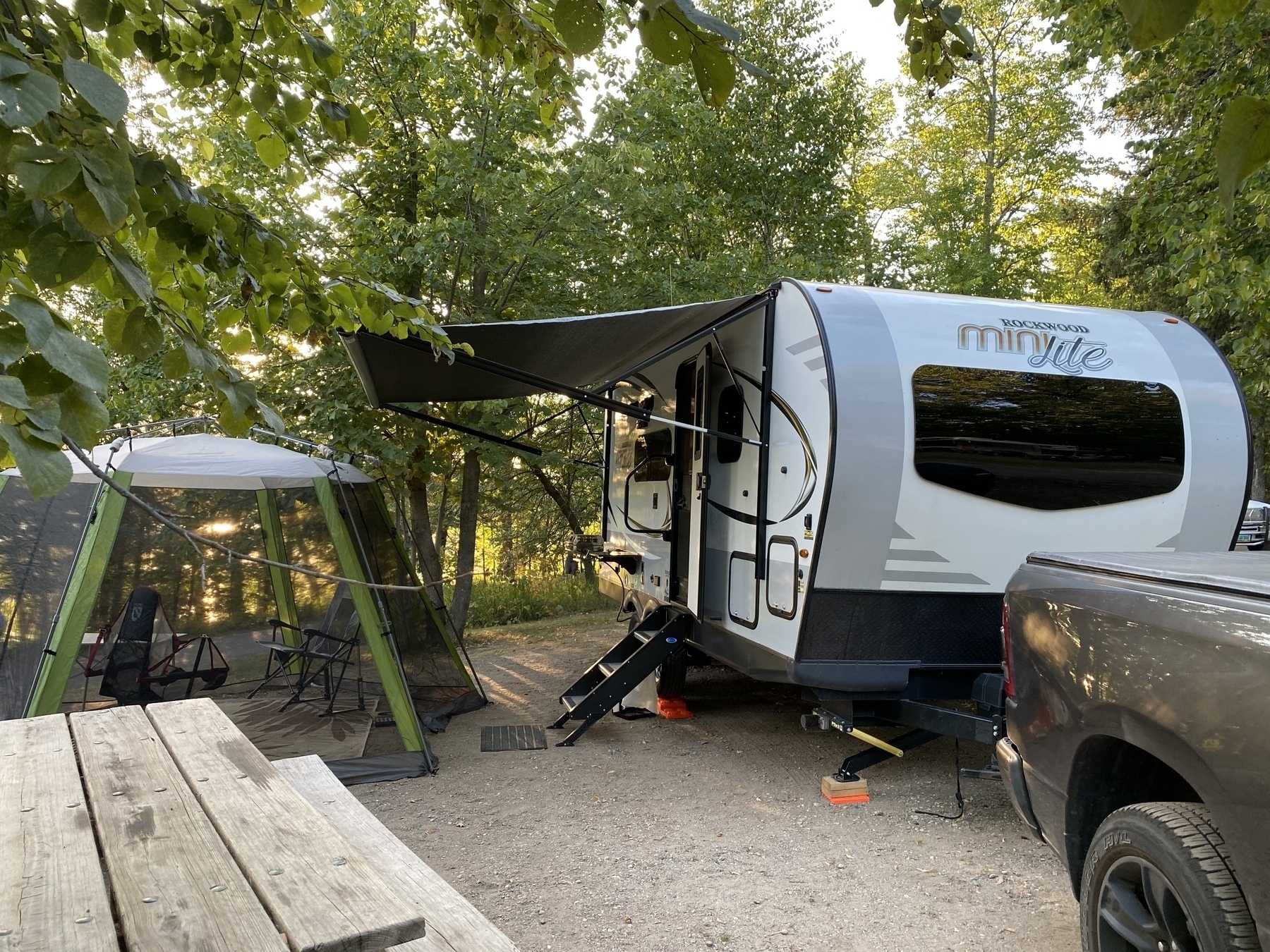
Our ride today was not what we expected since the wilderness road was closed due to downed trees and a high fire forrest fire risk 🌲 🔥. So we ended up doing more of the ride on the wonderful state park trails.
Tomorrow I’ll rest my legs for a day and then Monday I will take off for Bemidji.
Three Days in Chelan
Well, I think it is time to head East. When we started making our egg scramble for breakfast this morning the sausage had mold on it, and so did one of our bags of shredded cheese! Its nothing that a stop at a grocery store won’t fix, but we are both ready anyway. We’ve been on the road with the camper for 20 days, and it has been quite a trip.
The last few days have been really wonderful. We got to park the camper at Lake Chelan State Park and hang out with our friends Jim and Karen for three days! Jim and Karen are experts on the Chelan and Leavenworth areas having both lived in the area before, so they had lots of great outings planned for us.
Day One, we met at the Wal-mart parking lot to leave the camper until check-in time and headed out for a wine tasting and lunch! We found a great location at Benson’s who also served a great local wood fired pizza. Check out this amazing view of Lake Chelan from our lunch stop!
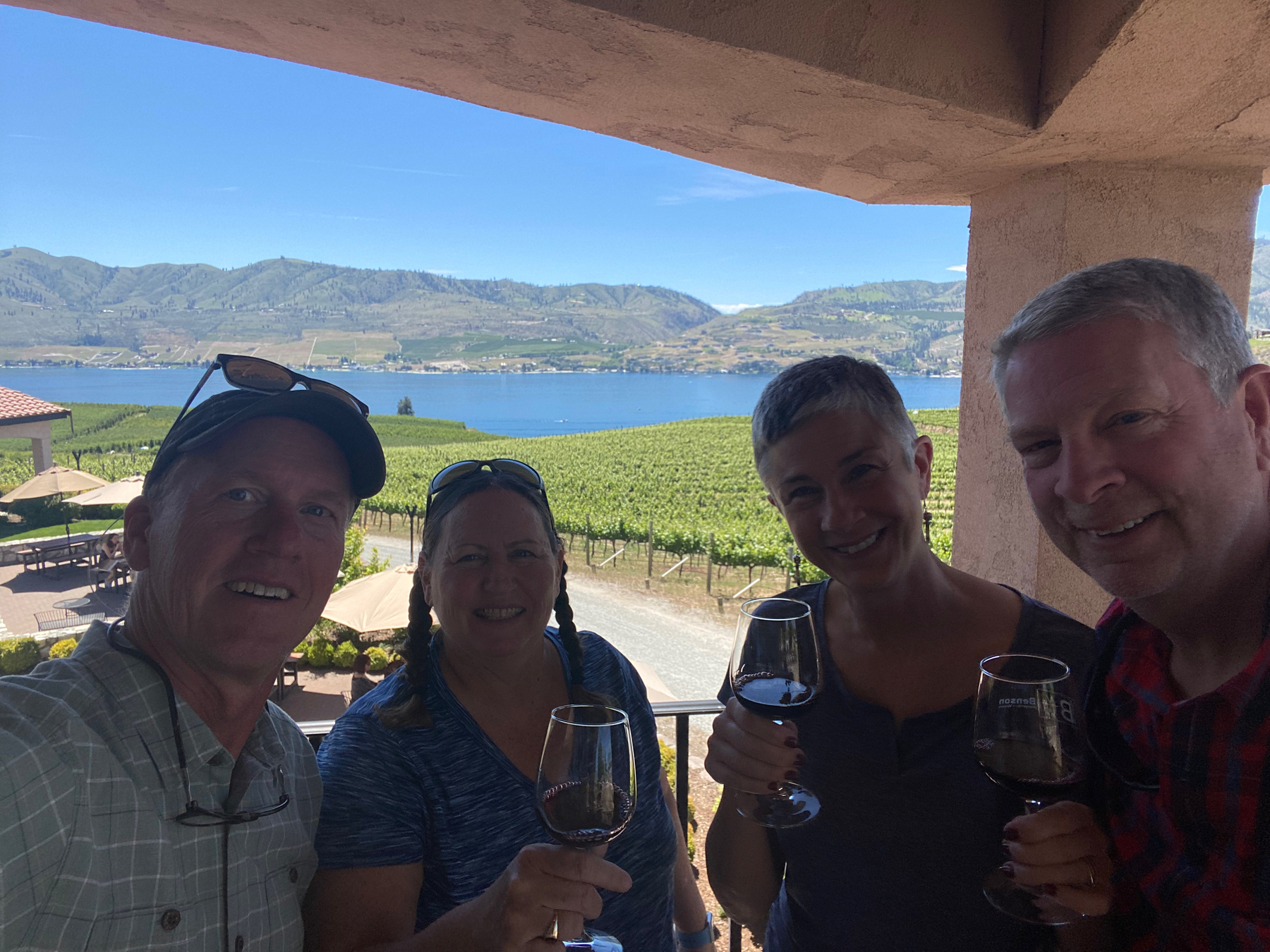
That pretty much captures the area in a nutshell. Everywhere you go you are treated to amazing views of the lake. By the time we finished lunch and our tasting it was late enough to move the camper to the campground.
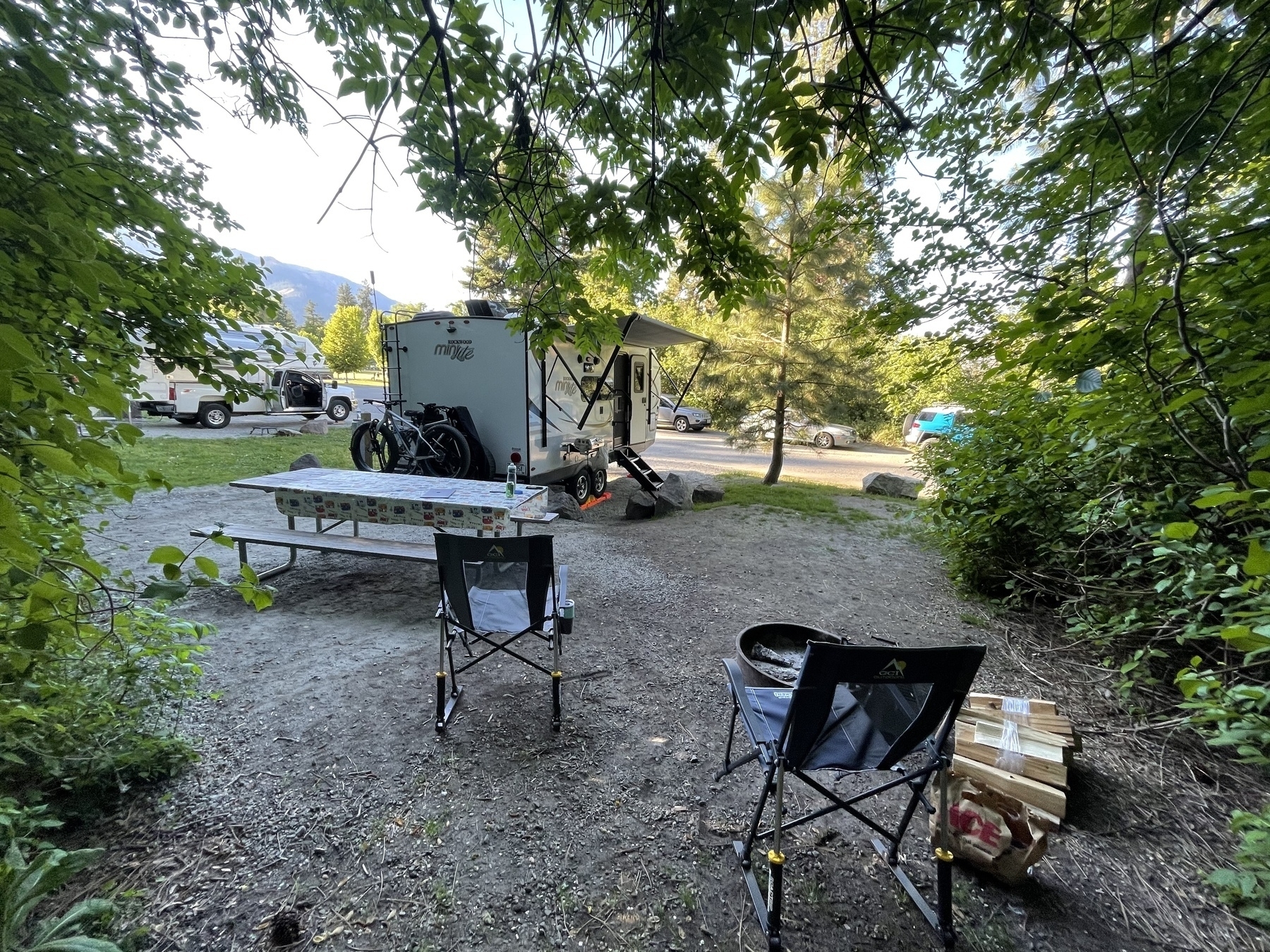
With the camper situated, we were able to explore the south side of the lake and see the Holden guest house that Jim helped build many years ago. We had another pre-dinner wine tasting at the Tsillan (pronounced Chelan) winery. The weather was HOT 95+ degrees. The wine was also really good. I’m bringing home bottles of Rosé and Pinot Grigio. Dinner was in downtown Chelan at Campbells, followed by a campfire back at our site. There were two big RV’s next door to us, each with a gaggle of kids and their bikes. The kids were riding their bikes back and forth, no hands, getting as close as they could to Jim and Karen’s car parked in front of our camper! This was making both Jim and Karen very nervous, and they were ready to make the drive back to their place anyway, so they left. Meanwhile the biking and the squeaky bike brakes continued long after dark! We laughed that we are edging ever closer to those old people that yell “get off my lawn!”
Tuesday morning, Jim and I headed out for a ride up the lake. It was perfect weather and a great morning for a ride. My fat tire had to work hard to keep up with Jim’s road bike.
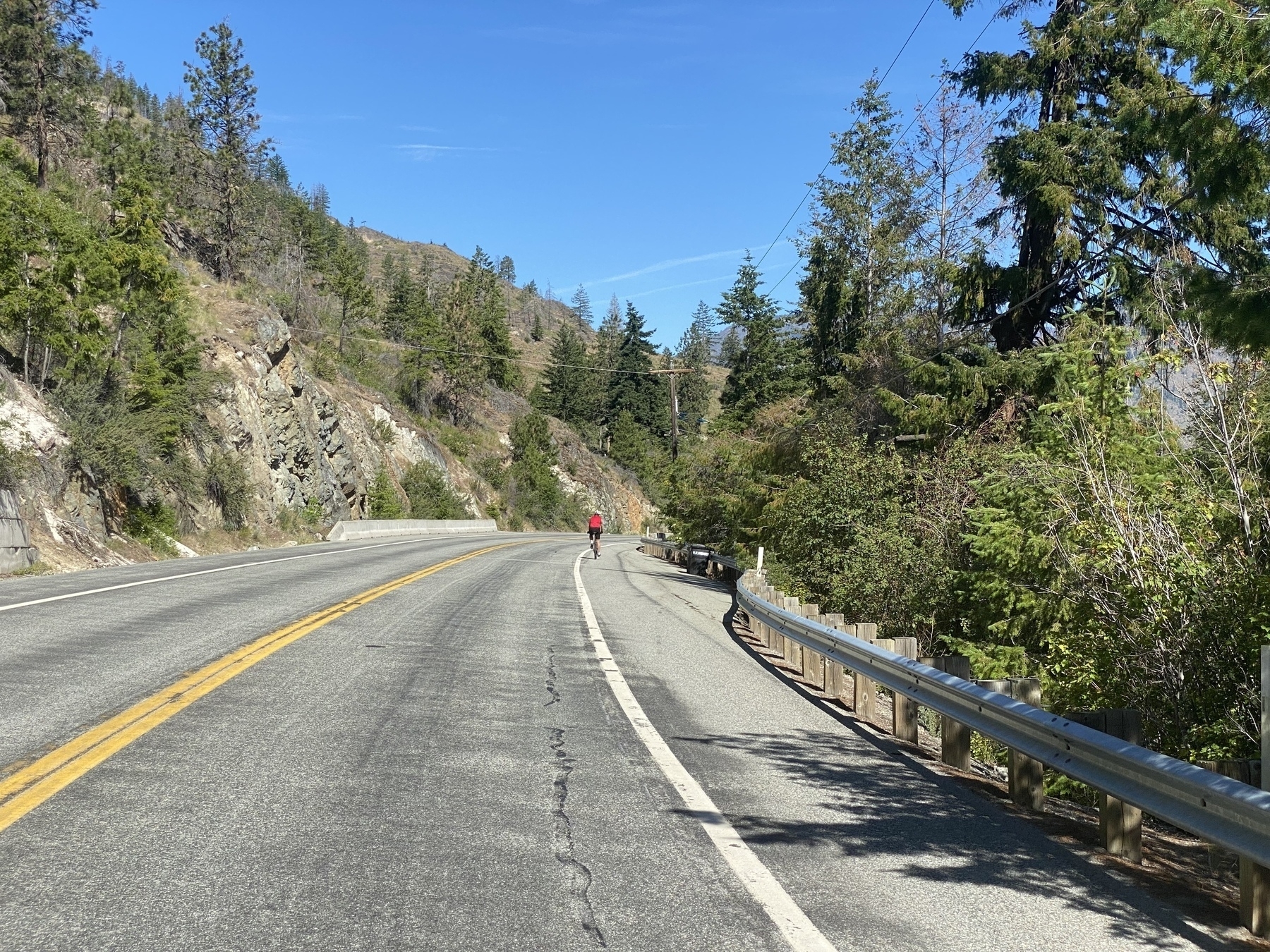
We had bratwurst for lunch at the campground, and then Jim and Karen took off to take care of some family things. We were also awaiting the arrival of Jane’s aunt Joanne and uncle Dale. Her cousin David drove them up from Yakima to see us. This is Jane’s last remaining aunt and uncle and we haven’t seen them in years so it was great to see them and have a chance to chat.
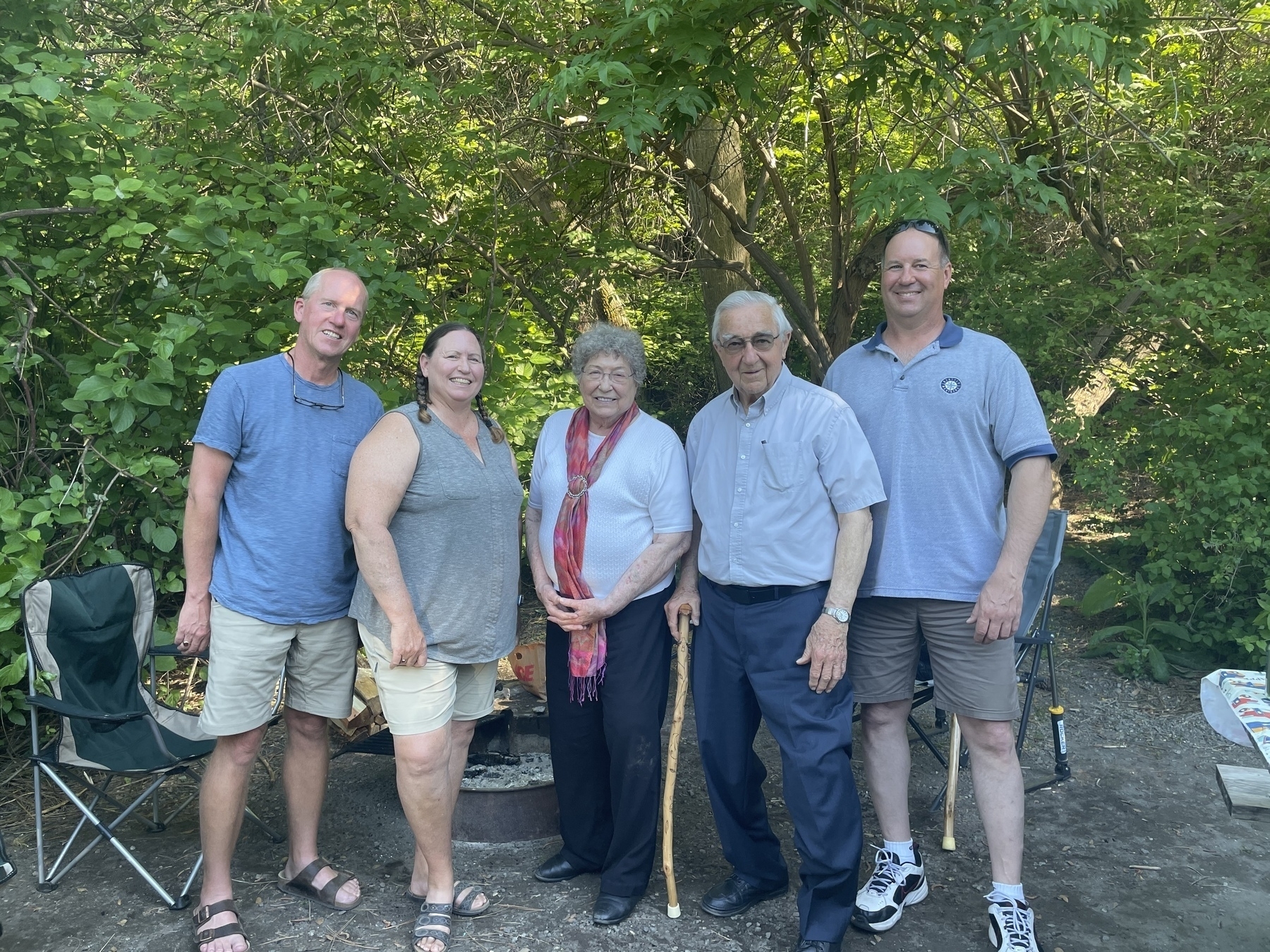
Wednesday, the plan was to head to Leavenworth, where Karen’s parents and cousins live. Karen had a favorite hike for us to do, and Jane’s cousin runs Visconti’s restaurant there. Leavenworth has been remodeled to resemble a Bavarian mountain village and is a charming little town. We enjoyed a lunch at a local Mexican restaurant (Yes, I know, not very Bavarian, but we just had brats for lunch on Tuesday). We visited the local fair trade store that was owned by Karen’s parents as well as the hat shop and toy shop owned by her uncle.
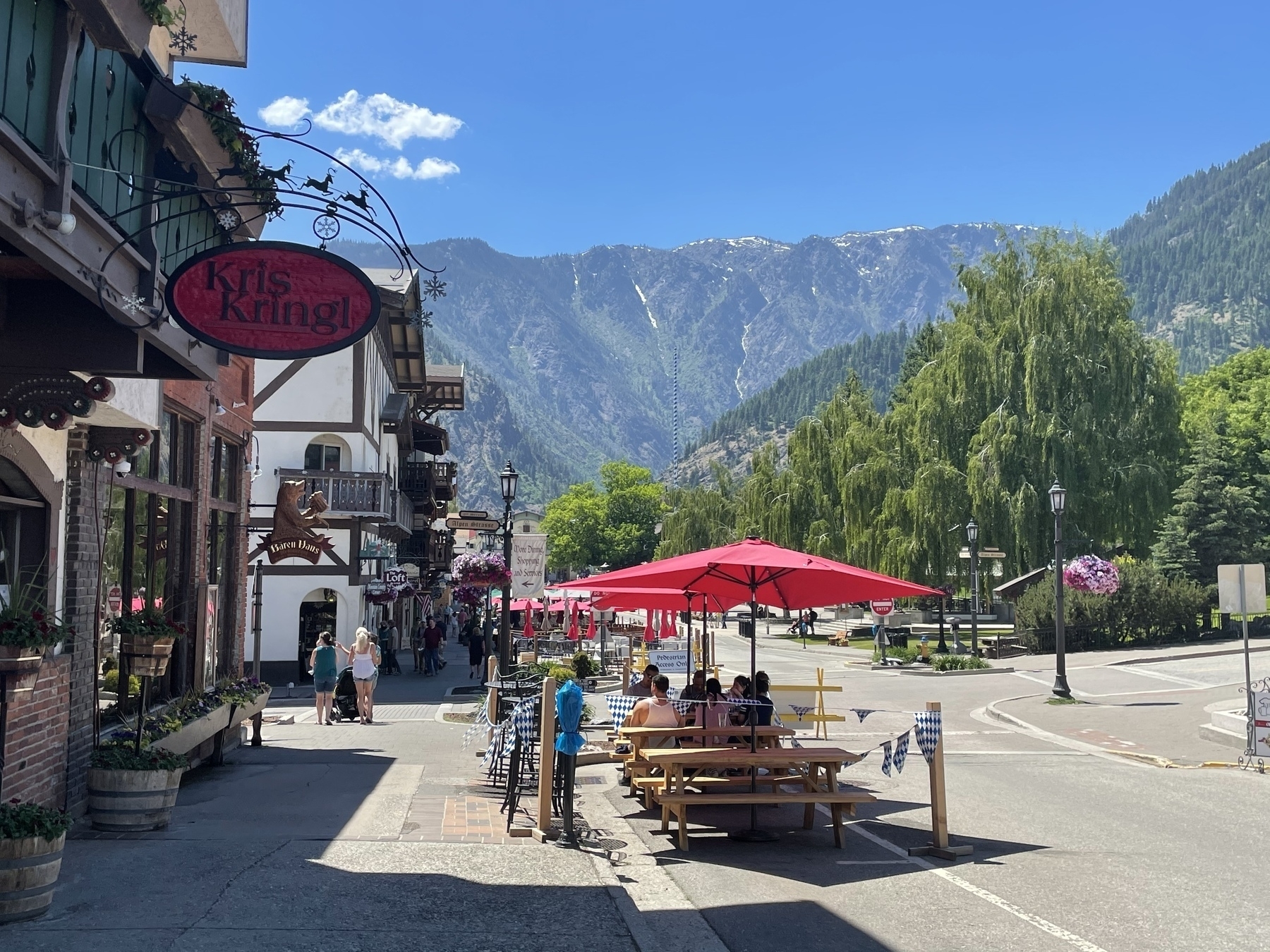
Downtown was really hot, so we headed up the mountain to take a hike along the Icicle river. The snow melt is fast and furious in the mountains so the rivers are really flowing.
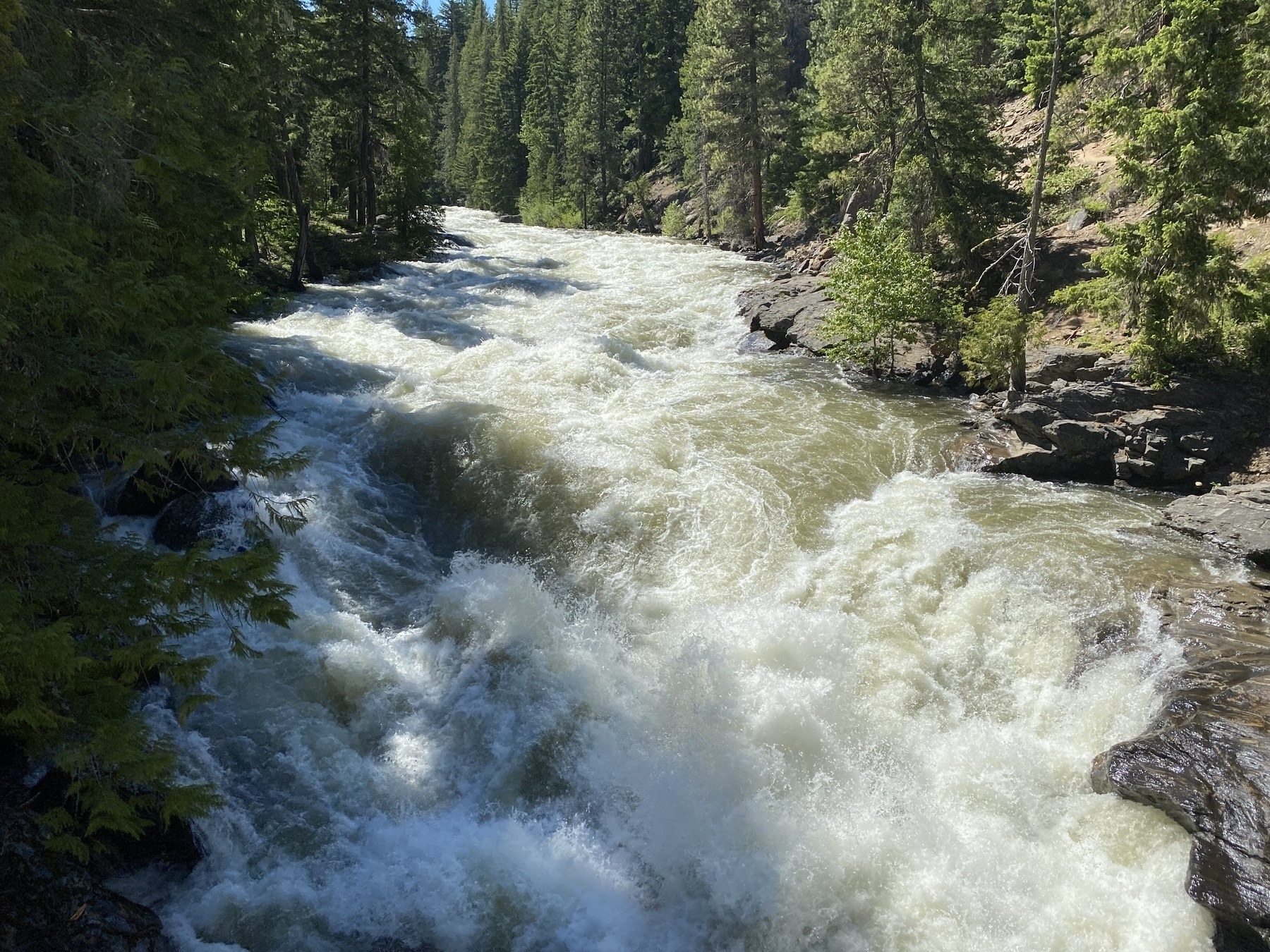
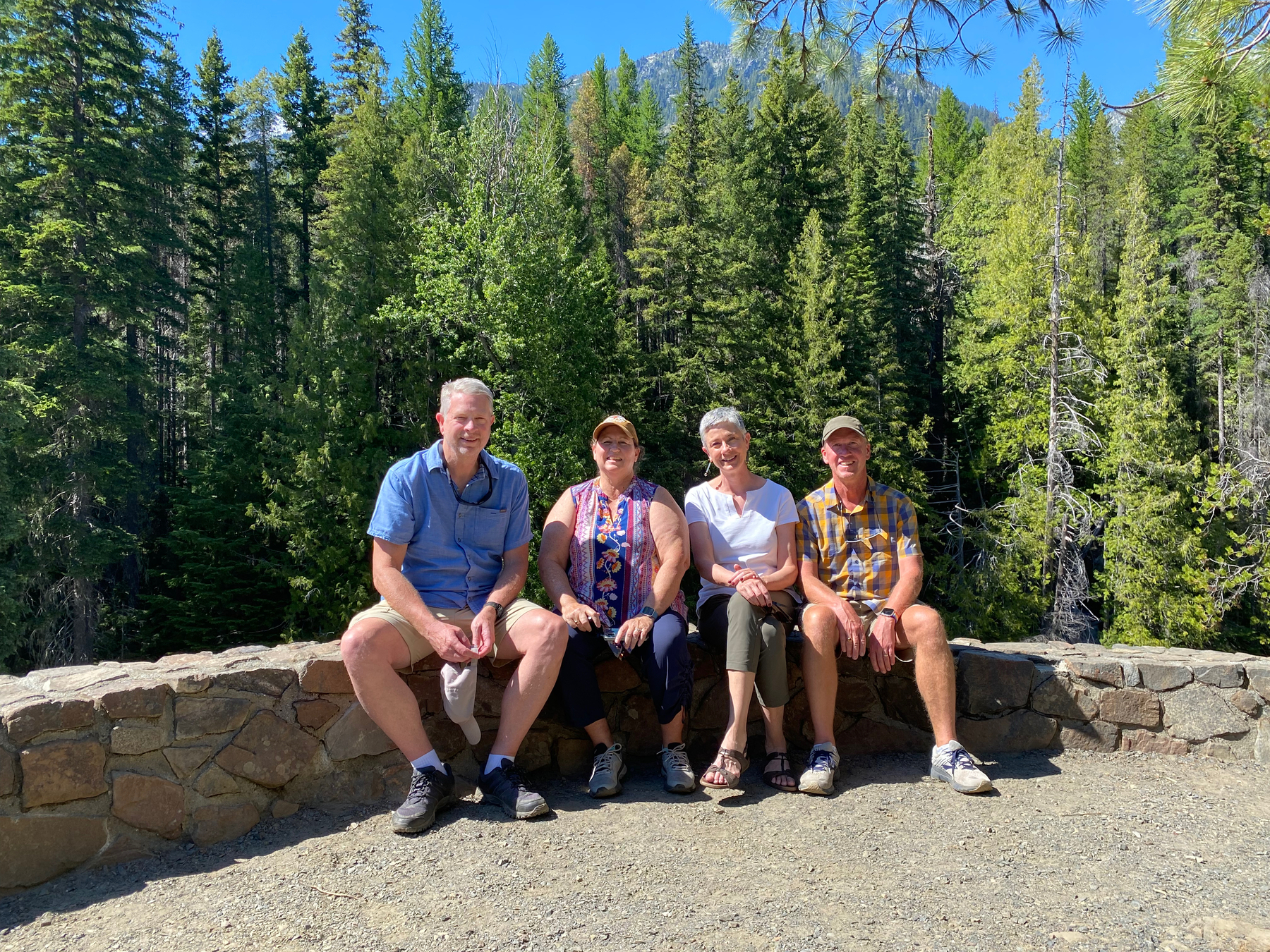
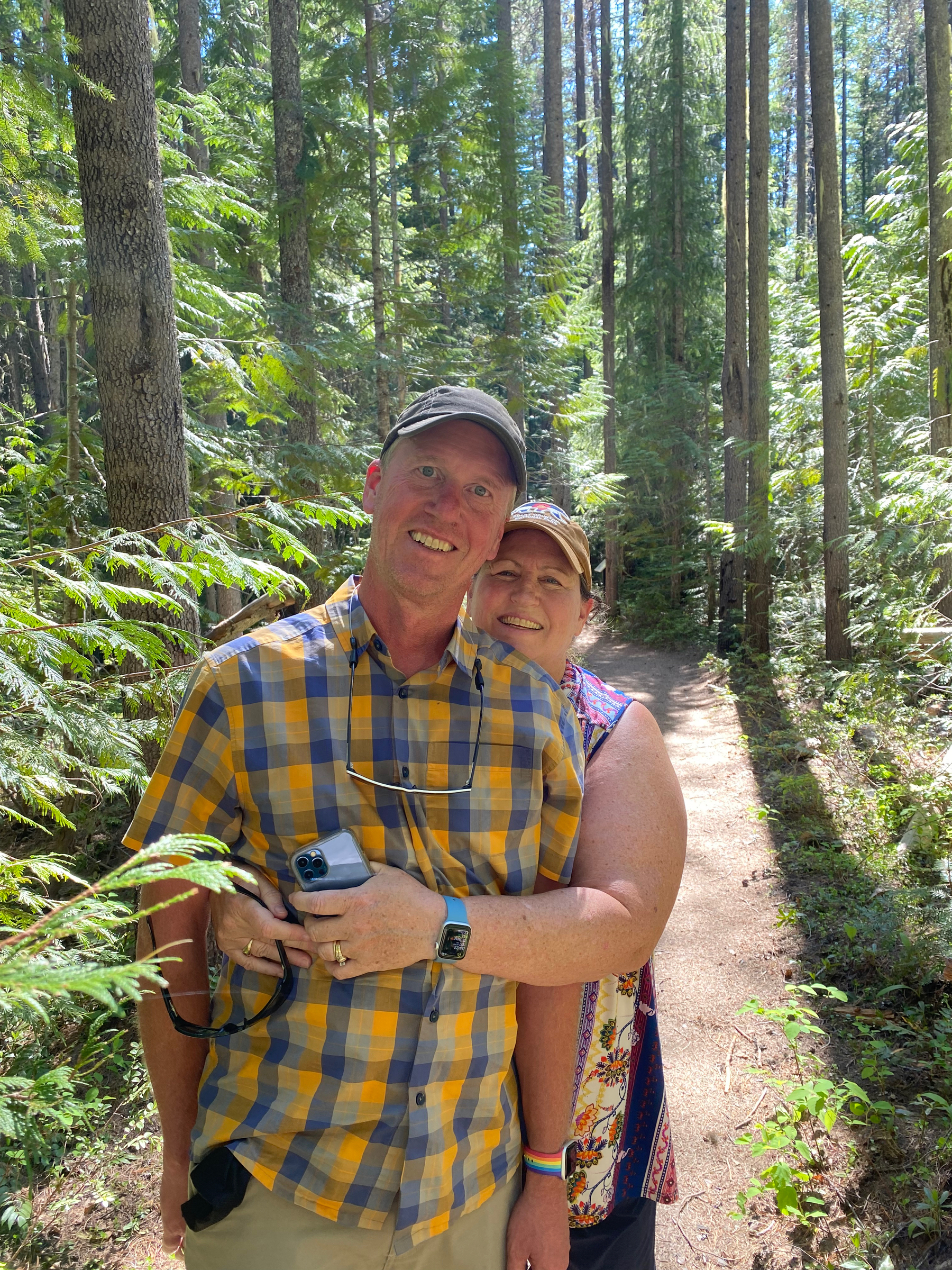
Although the water was very cold and the temperatures up on the mountain were much cooler we were still all pretty hot and tired after the hike. So we showed up for our reservation an hour early. No problem we enjoyed some more local wine and eventually ordered our meal.
Karen was going to spend a couple of days with her parents, helping out around the house, so we dropped her off before making the hour long trek back to the campground. By then we were tired so we just spent some time picking up the campsite and preparing for our morning departure.
The campsite was very tight, and in addition, there was a car parked right across from our site, making our exit very narrow. after getting the trailer hooked up Jane nearly had us out of the site except for the large rock blocking the corner of our site. I had tried to move it earlier in the morning in preparation for our exit but couldn’t move it. Luckily there was a burly young man doing his dishes at the water faucet on the edge of our site who said “I can move that rock for you”. together we rolled it over and we were able to get the camper out. Our next move was to wake up the tenters that owned the parked car and ask them to move it. Thankfully that was not needed.
Snowy Adventure
The North Cascades (America’s Alps) is a beautiful stop on our journey. Not to mention the warmest temperatures (72 degrees) since Indio! It is also Memorial Day weekend, and the place is a zoo! Cars are everywhere, people are everywhere. Its almost as if friends and families have been freed from a pandemic and are now happily gathering together again after more than a year of quarantine and social distance.
Case in point, our camping neighbors, with double the allowable tents on their campsite, two dogs (Luna and Lance) and countless children. My guess from looking at all of them on the trail is that they are all young tech workers who have made the trek to the National Park to enjoy a holiday together. I really wanted to poll everyone who passed us on the trail “Computer Science degree?”
After arriving and getting the camper situated we decided to hike the Thunder Knob Trail. The info Jane had on the trail said it was 425 feet of elevation gain. The park brochure said 625 feet, but my feet and legs were claiming even more! We had about a quarter of the trek up left to go when a pair of young girls skipped past us and announced “You have a LONG way to go to get to the top!”. Thanks for killing my spirit I muttered. It would not be a proper vacation without at least one hiking turning out to be way more challenging than you thought.
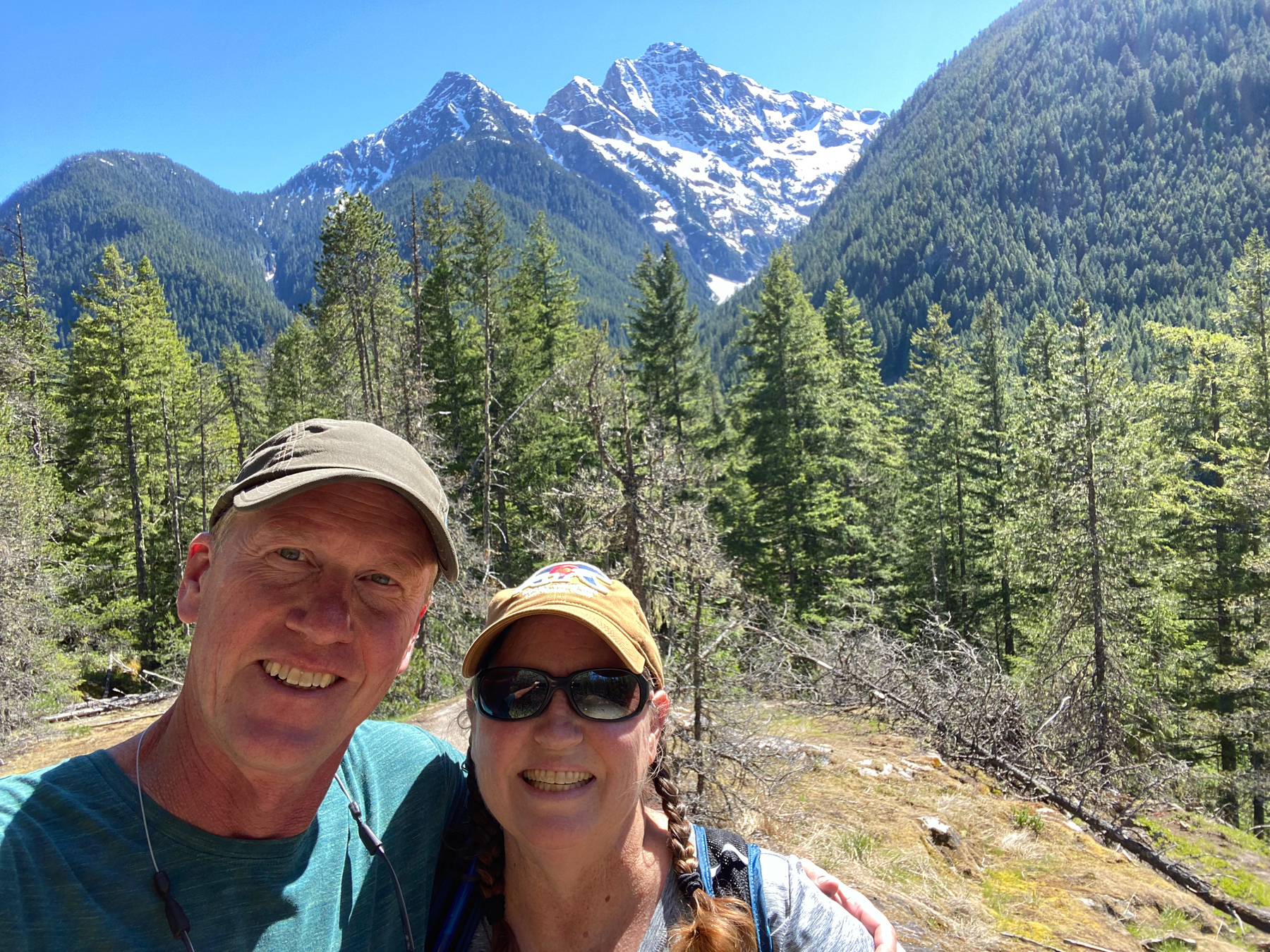
Nevertheless it was a spectacular view of Diablo Lake. The kind of place you could just sit and contemplate the beauty of nature, and remind yourself that there is a lot of good in our country.
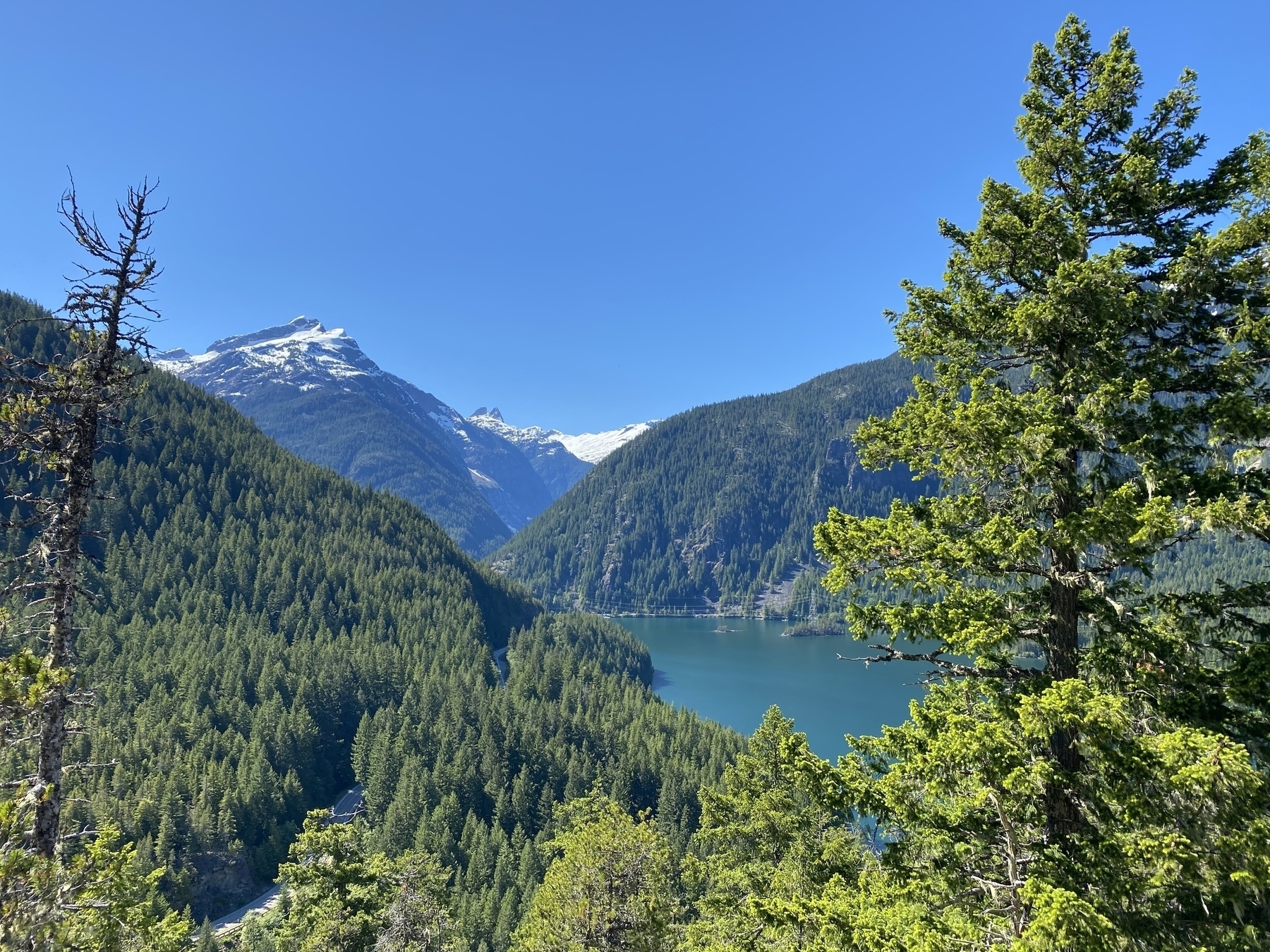
It was a perfect night for a campfire🔥 unfortunately we were lacking 🪵 🪵 The National Park prohibits gathering 🪵 as well as the sale of 🪵. We should have bought 🪵 in Marblemount from one of the friendly people on the side of the road! We made due with what our predecessors had left us in the fire ring and a little bit of kindling that was laying next to the 🔥 pit. The leftovers consisted of three large 🪵 that refused to really burn. Jane did her best to whittle down the 🪵 into smaller chunks but really only made more kindling. We managed to enjoy it all for a couple of hours anyway.
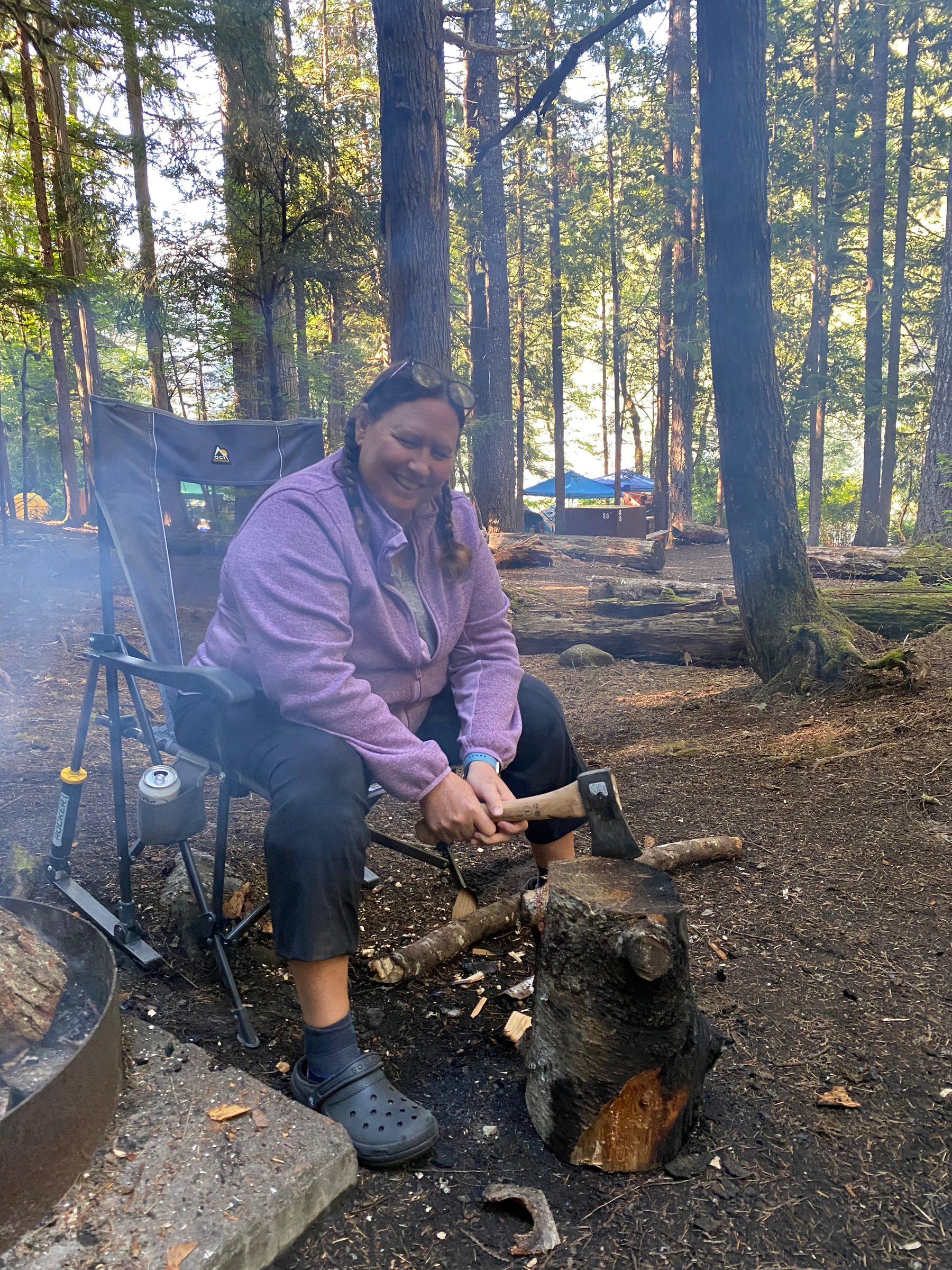
This morning we had many options! Jane had a very long list of hikes we could do. We decided to head for the furthest one called Blue Lake. Alas when we arrived at the trailhead the lot was still under many feet of snow. We hiked through the lot and attempted to find the trail itself, which did not look at all inviting.
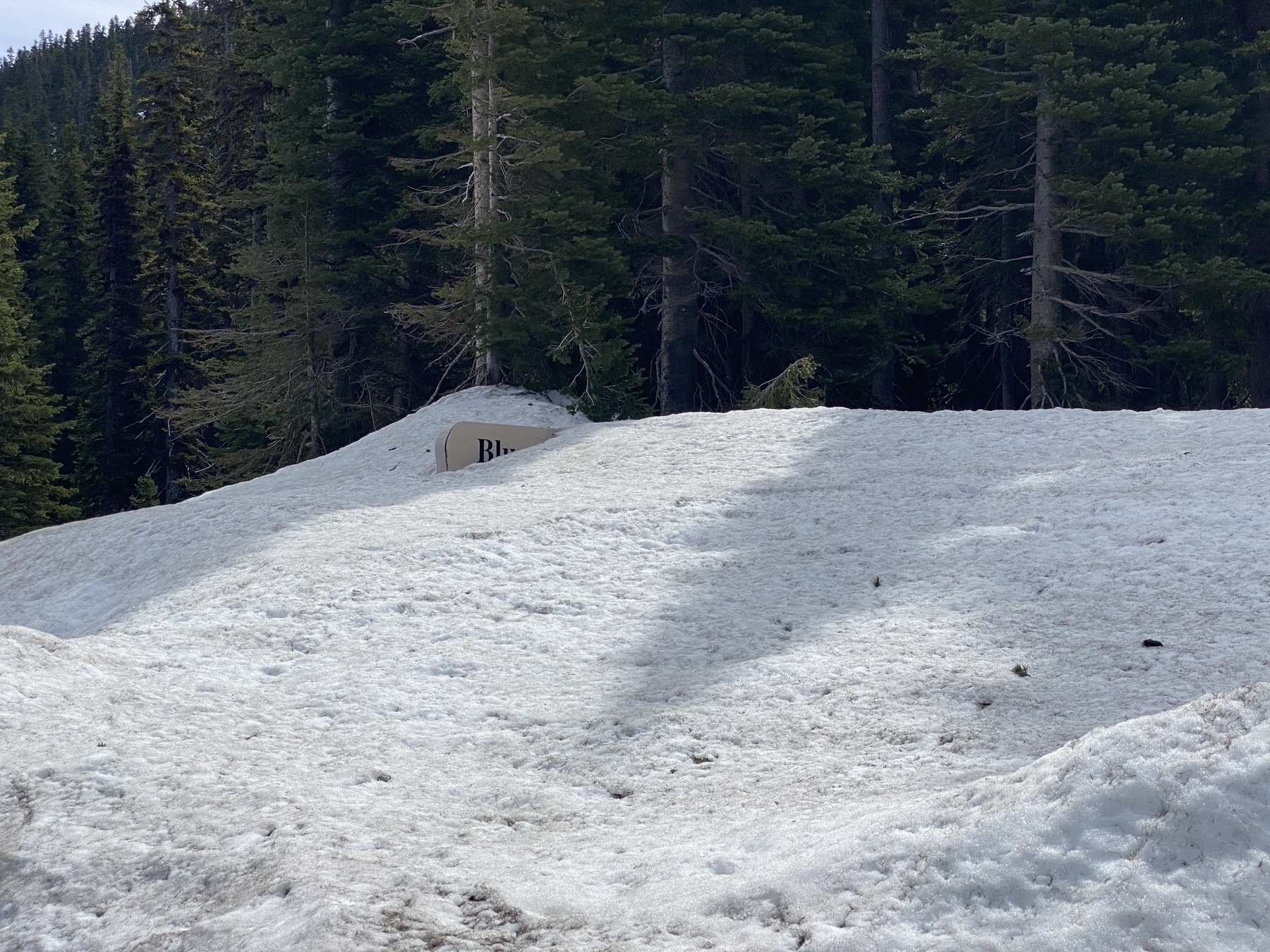
OK, for plan B we drove back toward camp thinking we would stop at Rainy Lake. It looked snowy as well, but the sheet we got from the ranger said that it was “A wheelchair-accessible paved trail to a mountain lake” How hard could it be? Our first clue should have been the couple and their dogs on skis! It turns out that when a wheelchair-accessible trail is under anywhere from 5 to 20 feet of snow it makes for a lot of ups and downs! Lots of slippery climbs and feet sinking six inches into the snow! In short, it was a snowy adventure (in shorts!) just trying to figure out where the trail was.
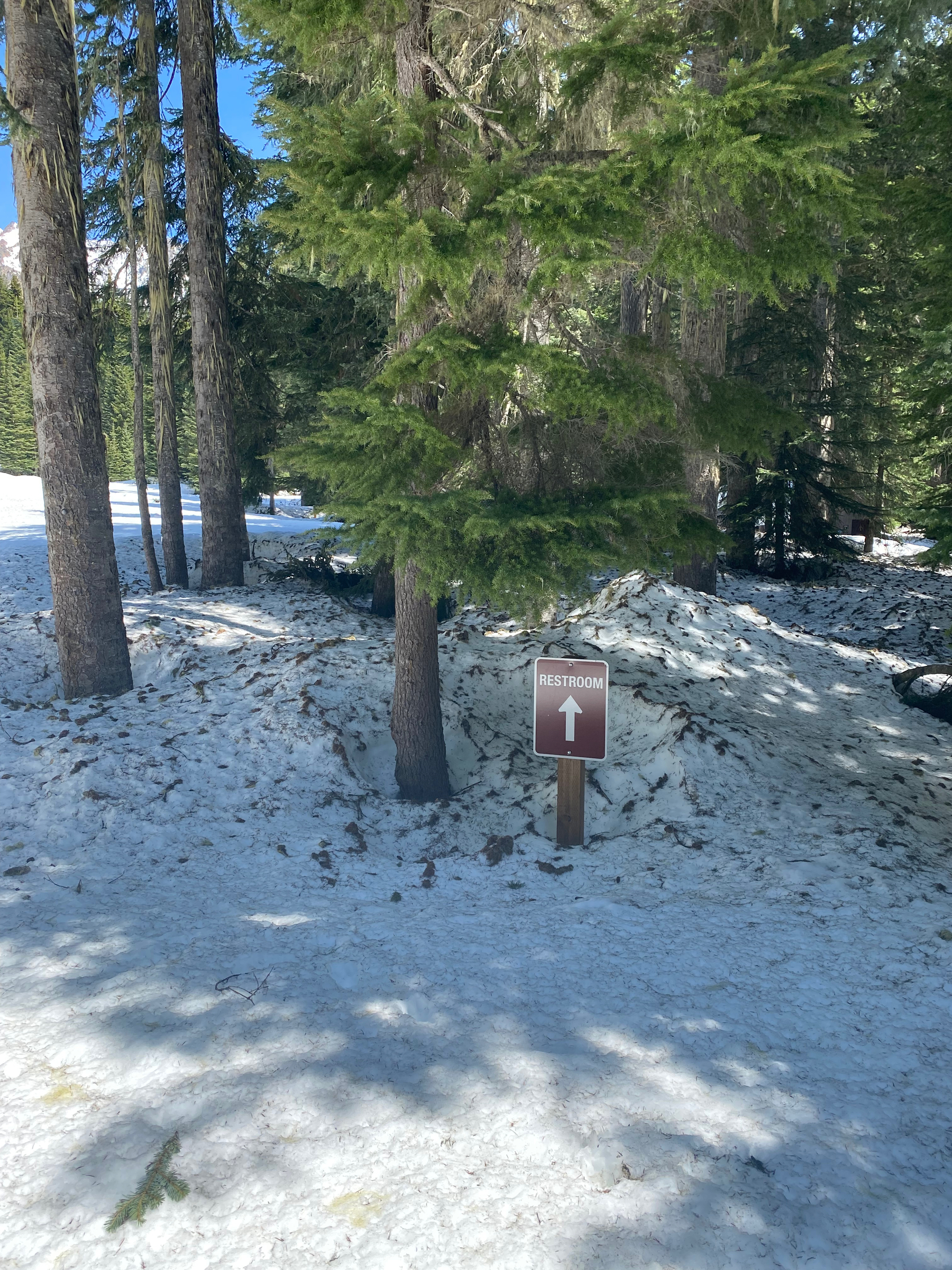
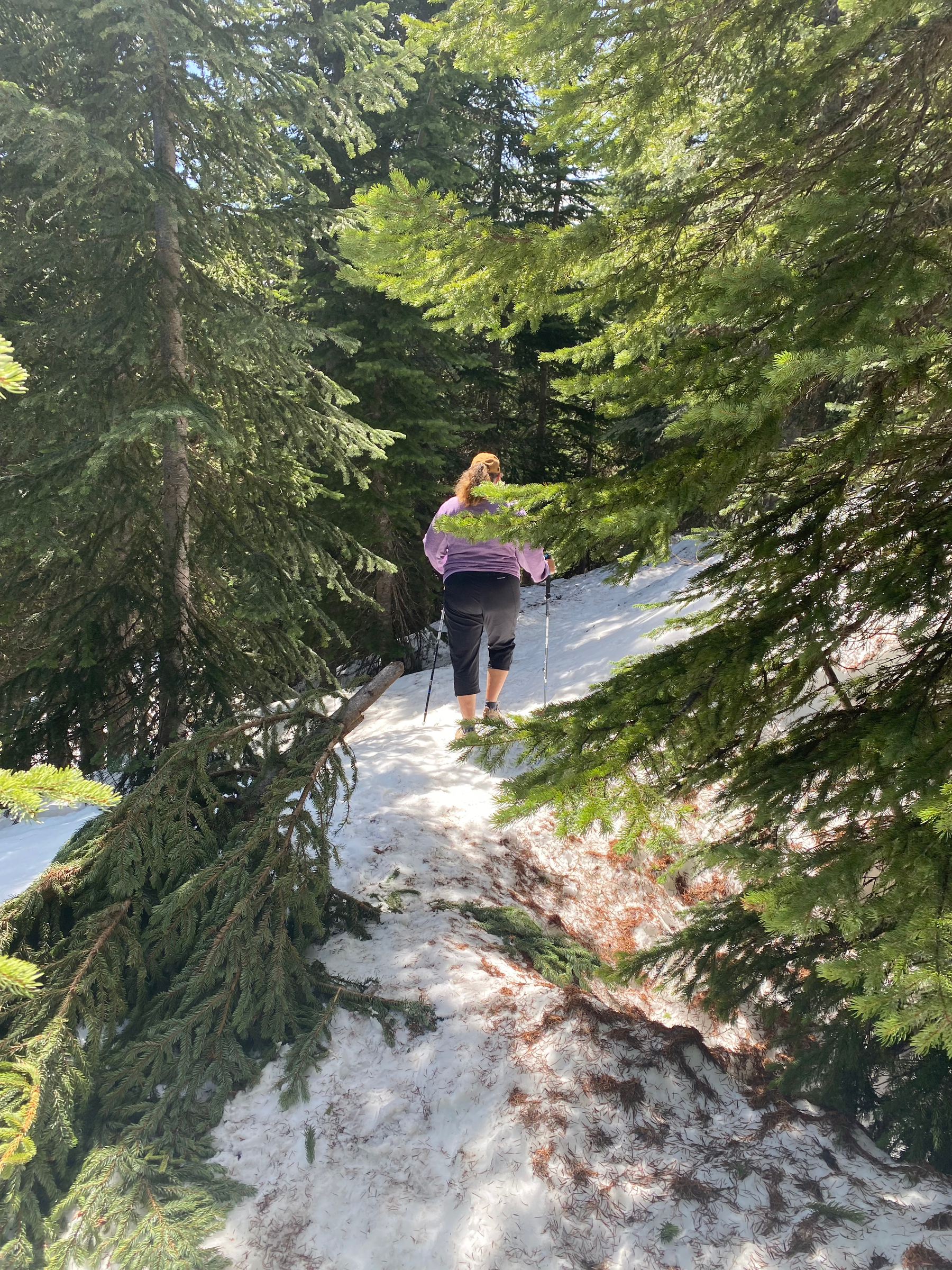
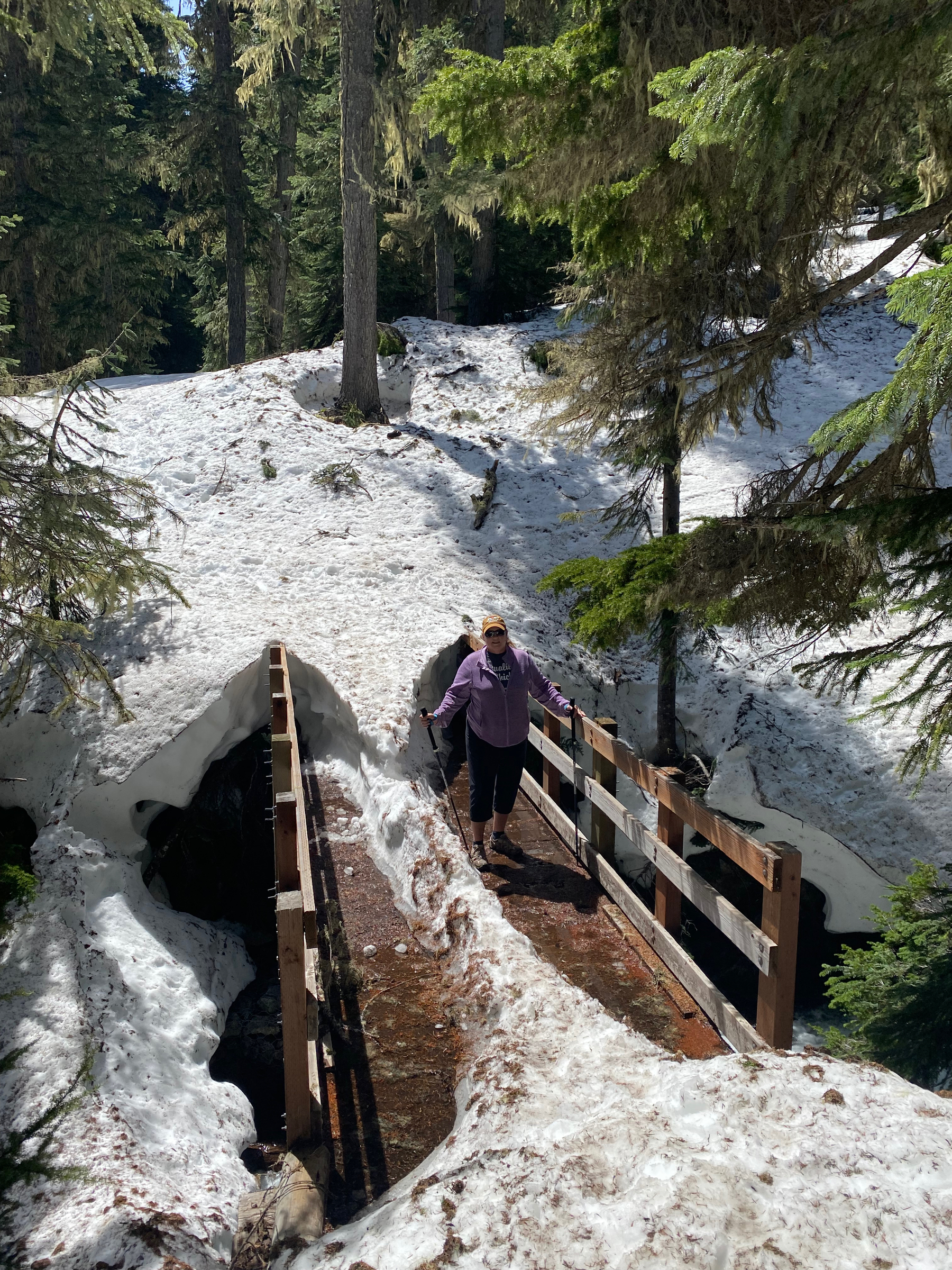
If Jane hadn’t downloaded the trail on her All-Trails app we would never have found the lake! We would trek a ways forward then stop and consult the map. inevitably we were off to one side or the other of the official trail. We were completely by ourselves, and I immediately thought about the warnings that there were bears and rattlesnakes about. Well, I was not worried about rattlesnakes! I wasn’t really worried about 🐻 either but the thought did cross my mind.
After all of our work to get to the lake it was definitely worth it, all the more so because there were only a few people there. A real contrast to the campground!
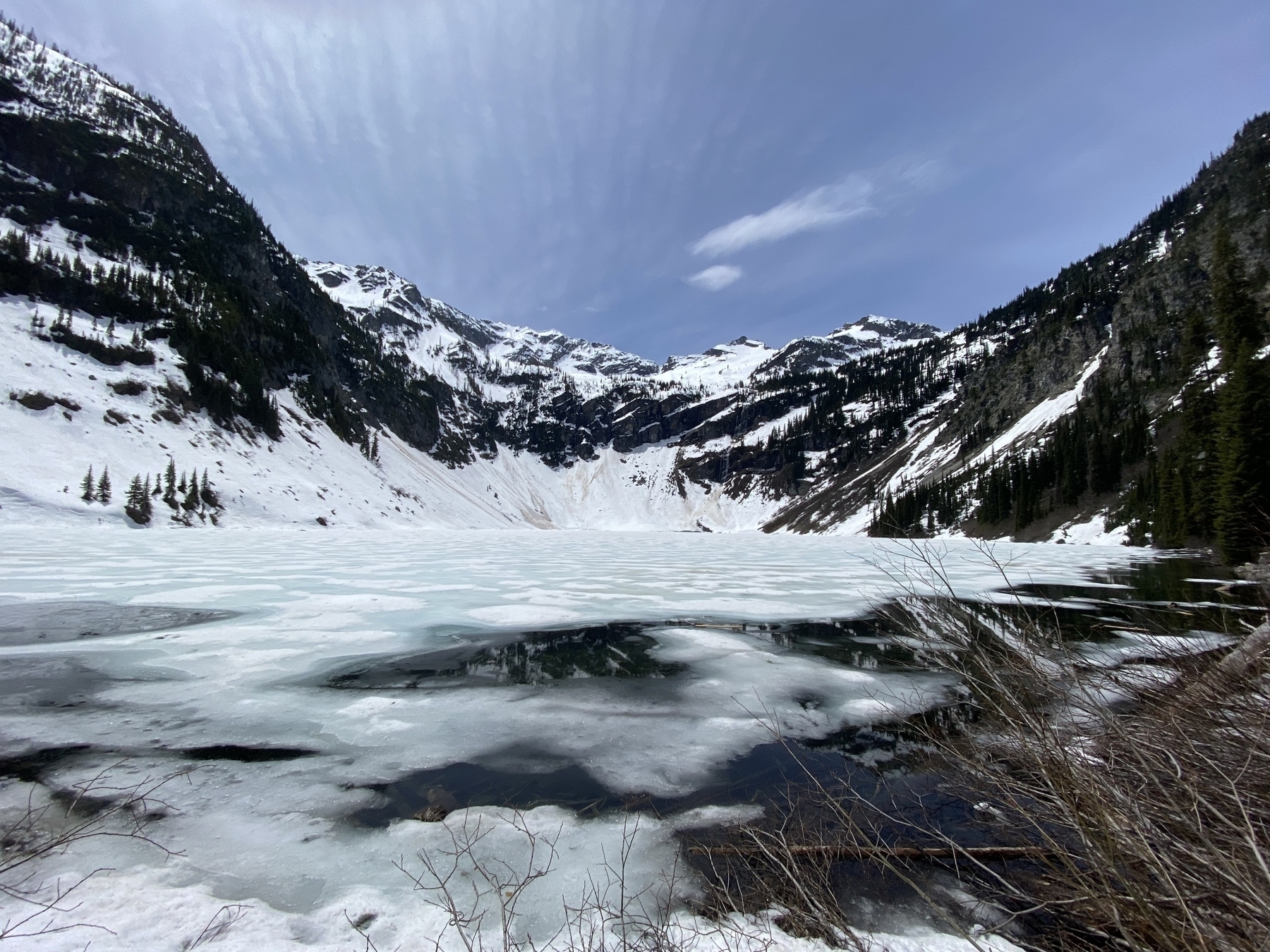
By the time we finished the hike Jane’s feet were soaked! We were both way more worn out than anyone would ever imagine after a simple two mile hike on a wheelchair-accessible trail 😂 On the way back to the campground we discussed our options. Jane had made a second reservation for tonight at Pearrygin State Park, in case it was too cold in the National Park. Its not cold, but we decided that we might as well make another 60 miles of progress this afternoon as another hike was not in the cards. Who knows how busy this campground will be but we might as well find out.
It turned out great! We have a great site right next to the lake, and it was a beautiful night to grill some steaks and enjoy a campfire. This time we stopped and supported the “neighborhood kids” outside of Winthrop by purchasing several bundles of 🪵 for our upcoming 🔥.